Quick filters:
Ancient egyptian ushabti Stock Photos and Images
 Ancient Egyptian ushabtis (funerary statuettes) dated from the late period of the 26th Dynasty (664-525 BC) on display in the National Archaeological Museum (Museo Archeologico Nazionale di Napoli) in Naples, Campania, Italy. Stock Photohttps://www.alamy.com/image-license-details/?v=1https://www.alamy.com/ancient-egyptian-ushabtis-funerary-statuettes-dated-from-the-late-period-of-the-26th-dynasty-664-525-bc-on-display-in-the-national-archaeological-museum-museo-archeologico-nazionale-di-napoli-in-naples-campania-italy-image181695107.html
Ancient Egyptian ushabtis (funerary statuettes) dated from the late period of the 26th Dynasty (664-525 BC) on display in the National Archaeological Museum (Museo Archeologico Nazionale di Napoli) in Naples, Campania, Italy. Stock Photohttps://www.alamy.com/image-license-details/?v=1https://www.alamy.com/ancient-egyptian-ushabtis-funerary-statuettes-dated-from-the-late-period-of-the-26th-dynasty-664-525-bc-on-display-in-the-national-archaeological-museum-museo-archeologico-nazionale-di-napoli-in-naples-campania-italy-image181695107.htmlRMMFGWXY–Ancient Egyptian ushabtis (funerary statuettes) dated from the late period of the 26th Dynasty (664-525 BC) on display in the National Archaeological Museum (Museo Archeologico Nazionale di Napoli) in Naples, Campania, Italy.
 Egyptian Grave Goods - Shabti Figures Stock Photohttps://www.alamy.com/image-license-details/?v=1https://www.alamy.com/stock-photo-egyptian-grave-goods-shabti-figures-51432507.html
Egyptian Grave Goods - Shabti Figures Stock Photohttps://www.alamy.com/image-license-details/?v=1https://www.alamy.com/stock-photo-egyptian-grave-goods-shabti-figures-51432507.htmlRMCYJXK7–Egyptian Grave Goods - Shabti Figures
 View of Egyptian Ushabtis figures. Ushabti (shabti or shawabti) is a funerary figurine used in ancient Egyptian religion. Stock Photohttps://www.alamy.com/image-license-details/?v=1https://www.alamy.com/view-of-egyptian-ushabtis-figures-ushabti-shabti-or-shawabti-is-a-funerary-figurine-used-in-ancient-egyptian-religion-image454986086.html
View of Egyptian Ushabtis figures. Ushabti (shabti or shawabti) is a funerary figurine used in ancient Egyptian religion. Stock Photohttps://www.alamy.com/image-license-details/?v=1https://www.alamy.com/view-of-egyptian-ushabtis-figures-ushabti-shabti-or-shawabti-is-a-funerary-figurine-used-in-ancient-egyptian-religion-image454986086.htmlRF2HC6BB2–View of Egyptian Ushabtis figures. Ushabti (shabti or shawabti) is a funerary figurine used in ancient Egyptian religion.
 An ancient, very worn Egyptian sshabti lying in sand. Stock Photohttps://www.alamy.com/image-license-details/?v=1https://www.alamy.com/an-ancient-very-worn-egyptian-sshabti-lying-in-sand-image383409629.html
An ancient, very worn Egyptian sshabti lying in sand. Stock Photohttps://www.alamy.com/image-license-details/?v=1https://www.alamy.com/an-ancient-very-worn-egyptian-sshabti-lying-in-sand-image383409629.htmlRF2D7NPW1–An ancient, very worn Egyptian sshabti lying in sand.
 Egyptian funerary figures ushabtis, Memphis, 500 BC at the Louvre Museum, Paris, France Stock Photohttps://www.alamy.com/image-license-details/?v=1https://www.alamy.com/stock-photo-egyptian-funerary-figures-ushabtis-memphis-500-bc-at-the-louvre-museum-72448601.html
Egyptian funerary figures ushabtis, Memphis, 500 BC at the Louvre Museum, Paris, France Stock Photohttps://www.alamy.com/image-license-details/?v=1https://www.alamy.com/stock-photo-egyptian-funerary-figures-ushabtis-memphis-500-bc-at-the-louvre-museum-72448601.htmlRME5T8X1–Egyptian funerary figures ushabtis, Memphis, 500 BC at the Louvre Museum, Paris, France
 Ancient Egypt. Ushabtis. Funerary figurine. The State Hermitage Museum. Saint Petersburg. Russia. Stock Photohttps://www.alamy.com/image-license-details/?v=1https://www.alamy.com/stock-photo-ancient-egypt-ushabtis-funerary-figurine-the-state-hermitage-museum-106873723.html
Ancient Egypt. Ushabtis. Funerary figurine. The State Hermitage Museum. Saint Petersburg. Russia. Stock Photohttps://www.alamy.com/image-license-details/?v=1https://www.alamy.com/stock-photo-ancient-egypt-ushabtis-funerary-figurine-the-state-hermitage-museum-106873723.htmlRMG5TEEK–Ancient Egypt. Ushabtis. Funerary figurine. The State Hermitage Museum. Saint Petersburg. Russia.
 geography/travel, Egypt, death cult, eight shabti, faience, Late Period, State Collection of Egyptian Art, Munich, ancient world, sculpture, figures, ushabti, fine arts, historic, historical, ancient world, Stock Photohttps://www.alamy.com/image-license-details/?v=1https://www.alamy.com/stock-photo-geographytravel-egypt-death-cult-eight-shabti-faience-late-period-12825246.html
geography/travel, Egypt, death cult, eight shabti, faience, Late Period, State Collection of Egyptian Art, Munich, ancient world, sculpture, figures, ushabti, fine arts, historic, historical, ancient world, Stock Photohttps://www.alamy.com/image-license-details/?v=1https://www.alamy.com/stock-photo-geographytravel-egypt-death-cult-eight-shabti-faience-late-period-12825246.htmlRMAB9W1K–geography/travel, Egypt, death cult, eight shabti, faience, Late Period, State Collection of Egyptian Art, Munich, ancient world, sculpture, figures, ushabti, fine arts, historic, historical, ancient world,
 Ancient Egyptian Ushabti box, 664-332 BC, Thebes, painted wood. Louvre Museum N2697. Decoration: front side; the 4 sons of Horus (standing); isis : ta Stock Photohttps://www.alamy.com/image-license-details/?v=1https://www.alamy.com/ancient-egyptian-ushabti-box-664-332-bc-thebes-painted-wood-louvre-museum-n2697-decoration-front-side-the-4-sons-of-horus-standing-isis-ta-image450428716.html
Ancient Egyptian Ushabti box, 664-332 BC, Thebes, painted wood. Louvre Museum N2697. Decoration: front side; the 4 sons of Horus (standing); isis : ta Stock Photohttps://www.alamy.com/image-license-details/?v=1https://www.alamy.com/ancient-egyptian-ushabti-box-664-332-bc-thebes-painted-wood-louvre-museum-n2697-decoration-front-side-the-4-sons-of-horus-standing-isis-ta-image450428716.htmlRF2H4PPBT–Ancient Egyptian Ushabti box, 664-332 BC, Thebes, painted wood. Louvre Museum N2697. Decoration: front side; the 4 sons of Horus (standing); isis : ta
 Leiden, The Netherlands JAN 26, 2019: closeup of ancient shabtis, egyptian figurines at the exhibition Gods of Egypt in Leiden. Stock Photohttps://www.alamy.com/image-license-details/?v=1https://www.alamy.com/leiden-the-netherlands-jan-26-2019-closeup-of-ancient-shabtis-egyptian-figurines-at-the-exhibition-gods-of-egypt-in-leiden-image362718184.html
Leiden, The Netherlands JAN 26, 2019: closeup of ancient shabtis, egyptian figurines at the exhibition Gods of Egypt in Leiden. Stock Photohttps://www.alamy.com/image-license-details/?v=1https://www.alamy.com/leiden-the-netherlands-jan-26-2019-closeup-of-ancient-shabtis-egyptian-figurines-at-the-exhibition-gods-of-egypt-in-leiden-image362718184.htmlRF2C236MT–Leiden, The Netherlands JAN 26, 2019: closeup of ancient shabtis, egyptian figurines at the exhibition Gods of Egypt in Leiden.
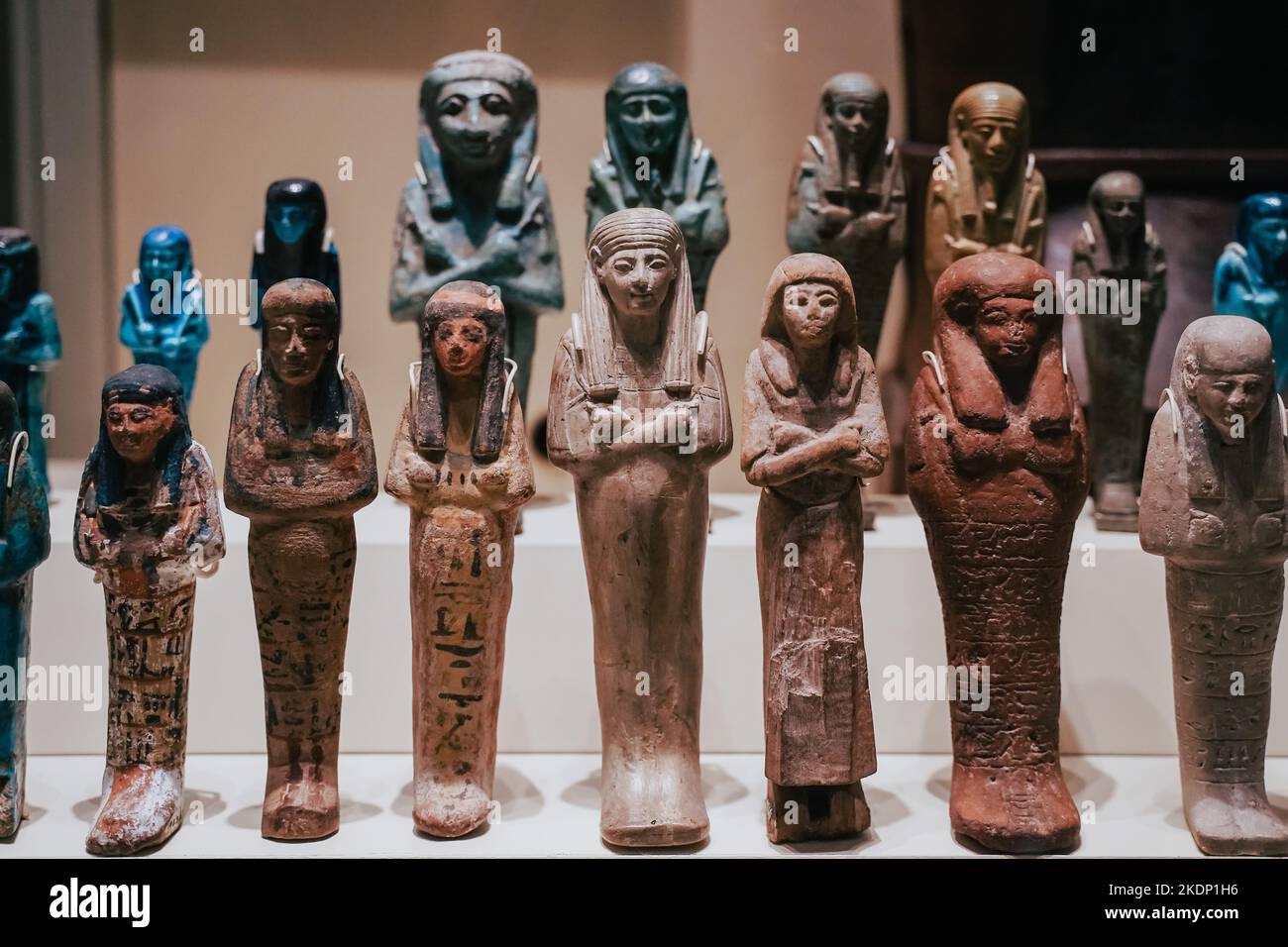 A shabti (also known as shawabti or ushabti) is a generally mummiform figurine of about 5 - 30 centimetres found in many ancient Egyptian tombs. They Stock Photohttps://www.alamy.com/image-license-details/?v=1https://www.alamy.com/a-shabti-also-known-as-shawabti-or-ushabti-is-a-generally-mummiform-figurine-of-about-5-30-centimetres-found-in-many-ancient-egyptian-tombs-they-image490365042.html
A shabti (also known as shawabti or ushabti) is a generally mummiform figurine of about 5 - 30 centimetres found in many ancient Egyptian tombs. They Stock Photohttps://www.alamy.com/image-license-details/?v=1https://www.alamy.com/a-shabti-also-known-as-shawabti-or-ushabti-is-a-generally-mummiform-figurine-of-about-5-30-centimetres-found-in-many-ancient-egyptian-tombs-they-image490365042.htmlRM2KDP1H6–A shabti (also known as shawabti or ushabti) is a generally mummiform figurine of about 5 - 30 centimetres found in many ancient Egyptian tombs. They
 statue of Ushabti of Hekanefer - Nubian Museim - Aswan, Upper Egypt Stock Photohttps://www.alamy.com/image-license-details/?v=1https://www.alamy.com/stock-photo-statue-of-ushabti-of-hekanefer-nubian-museim-aswan-upper-egypt-48330383.html
statue of Ushabti of Hekanefer - Nubian Museim - Aswan, Upper Egypt Stock Photohttps://www.alamy.com/image-license-details/?v=1https://www.alamy.com/stock-photo-statue-of-ushabti-of-hekanefer-nubian-museim-aswan-upper-egypt-48330383.htmlRMCPHHW3–statue of Ushabti of Hekanefer - Nubian Museim - Aswan, Upper Egypt
 An Egyptian wooden ushabti,17th/18th Dynasty around 1500 B.C. Full figure carving with remnants of paint on the eyes and wig. Base peg on the bottom with a slightly trapezoidal wooden base. The Arabic number '1168' appears on the front of the base. Wood somewhat weathered,and there are two knot holes on the side of the figure. Total height: 36.5 cm. Comes from an old private collection in Bochum. ,historic,historical,ancient world,ancient world,ancient times,object,objects,stills,clipping,cut out,cut-out,cut-outs,mediterranean,precious metal,pr,Additional-Rights-Clearences-Not Available Stock Photohttps://www.alamy.com/image-license-details/?v=1https://www.alamy.com/stock-photo-an-egyptian-wooden-ushabti17th18th-dynasty-around-1500-bc-full-figure-51538590.html
An Egyptian wooden ushabti,17th/18th Dynasty around 1500 B.C. Full figure carving with remnants of paint on the eyes and wig. Base peg on the bottom with a slightly trapezoidal wooden base. The Arabic number '1168' appears on the front of the base. Wood somewhat weathered,and there are two knot holes on the side of the figure. Total height: 36.5 cm. Comes from an old private collection in Bochum. ,historic,historical,ancient world,ancient world,ancient times,object,objects,stills,clipping,cut out,cut-out,cut-outs,mediterranean,precious metal,pr,Additional-Rights-Clearences-Not Available Stock Photohttps://www.alamy.com/image-license-details/?v=1https://www.alamy.com/stock-photo-an-egyptian-wooden-ushabti17th18th-dynasty-around-1500-bc-full-figure-51538590.htmlRMCYRNYX–An Egyptian wooden ushabti,17th/18th Dynasty around 1500 B.C. Full figure carving with remnants of paint on the eyes and wig. Base peg on the bottom with a slightly trapezoidal wooden base. The Arabic number '1168' appears on the front of the base. Wood somewhat weathered,and there are two knot holes on the side of the figure. Total height: 36.5 cm. Comes from an old private collection in Bochum. ,historic,historical,ancient world,ancient world,ancient times,object,objects,stills,clipping,cut out,cut-out,cut-outs,mediterranean,precious metal,pr,Additional-Rights-Clearences-Not Available
 Egyptian Ushabti or Ushabti. The Ushabti also called Ushabti or shawabti, was an Ancient Egyptian funerary figurine Stock Photohttps://www.alamy.com/image-license-details/?v=1https://www.alamy.com/stock-photo-egyptian-ushabti-or-ushabti-the-ushabti-also-called-ushabti-or-shawabti-90838883.html
Egyptian Ushabti or Ushabti. The Ushabti also called Ushabti or shawabti, was an Ancient Egyptian funerary figurine Stock Photohttps://www.alamy.com/image-license-details/?v=1https://www.alamy.com/stock-photo-egyptian-ushabti-or-ushabti-the-ushabti-also-called-ushabti-or-shawabti-90838883.htmlRMF7P1WR–Egyptian Ushabti or Ushabti. The Ushabti also called Ushabti or shawabti, was an Ancient Egyptian funerary figurine
 An ancient Egyptian ushabti on a pile of ancient Roman coins. Shallow depth of field, focus on the ushabti. Stock Photohttps://www.alamy.com/image-license-details/?v=1https://www.alamy.com/an-ancient-egyptian-ushabti-on-a-pile-of-ancient-roman-coins-shallow-depth-of-field-focus-on-the-ushabti-image363048192.html
An ancient Egyptian ushabti on a pile of ancient Roman coins. Shallow depth of field, focus on the ushabti. Stock Photohttps://www.alamy.com/image-license-details/?v=1https://www.alamy.com/an-ancient-egyptian-ushabti-on-a-pile-of-ancient-roman-coins-shallow-depth-of-field-focus-on-the-ushabti-image363048192.htmlRF2C2J7JT–An ancient Egyptian ushabti on a pile of ancient Roman coins. Shallow depth of field, focus on the ushabti.
 Ancient Egyptian. Ushabti (Funerary Figurine) of Horudja. 380 BC–343 BC. Egypt. Faience Stock Photohttps://www.alamy.com/image-license-details/?v=1https://www.alamy.com/ancient-egyptian-ushabti-funerary-figurine-of-horudja-380-bc343-bc-egypt-faience-image337974391.html
Ancient Egyptian. Ushabti (Funerary Figurine) of Horudja. 380 BC–343 BC. Egypt. Faience Stock Photohttps://www.alamy.com/image-license-details/?v=1https://www.alamy.com/ancient-egyptian-ushabti-funerary-figurine-of-horudja-380-bc343-bc-egypt-faience-image337974391.htmlRM2AHT1NY–Ancient Egyptian. Ushabti (Funerary Figurine) of Horudja. 380 BC–343 BC. Egypt. Faience
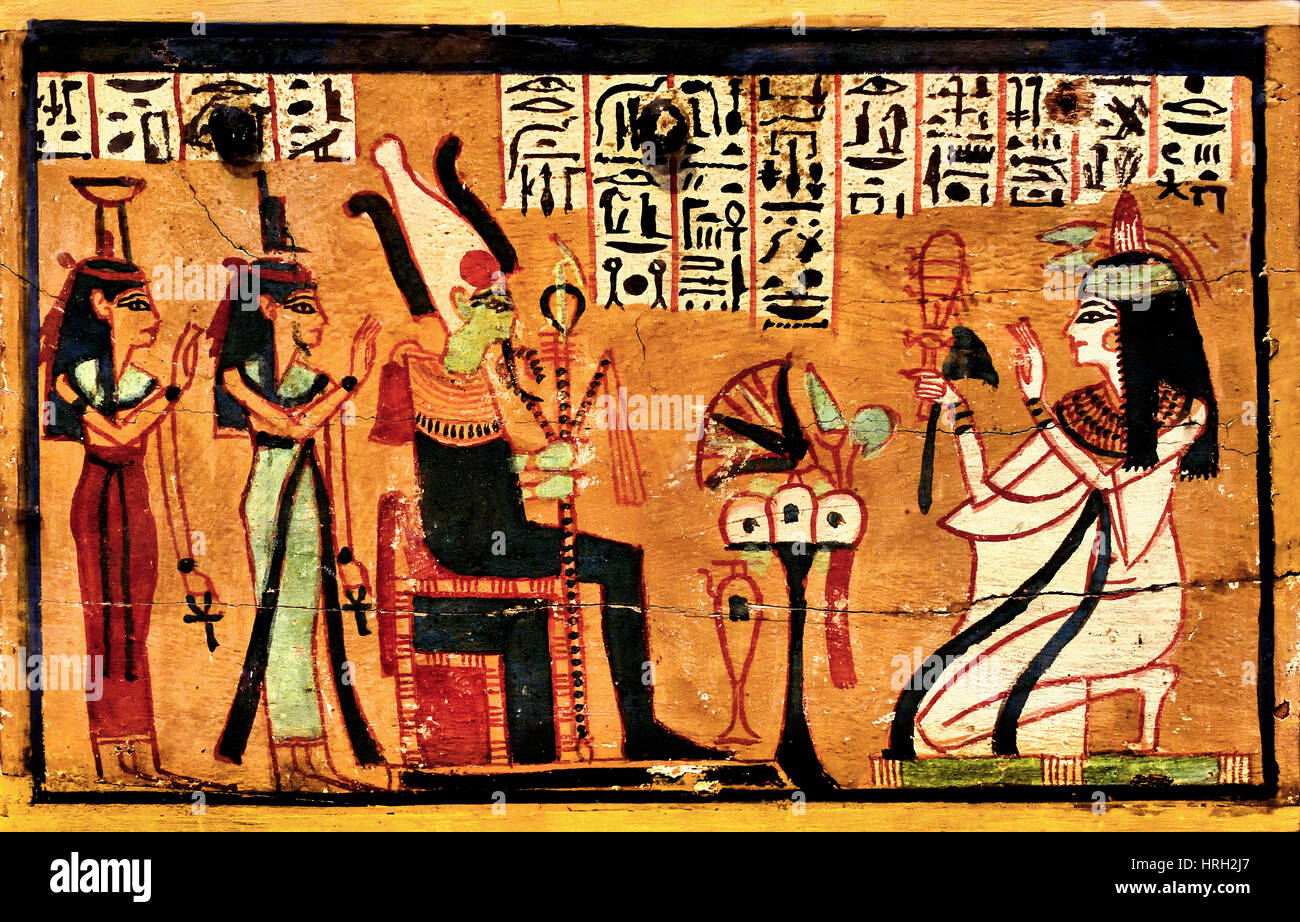 Berlin, New Museum, Uschebtikasten (New Museum, ushabti box) Uschebtis were often found in very large numbers in the graves because they were given as helpers to work in the afterlife for the deceased who lived there according to ancient Egyptian understanding. Stock Photohttps://www.alamy.com/image-license-details/?v=1https://www.alamy.com/stock-photo-berlin-new-museum-uschebtikasten-new-museum-ushabti-box-uschebtis-134984927.html
Berlin, New Museum, Uschebtikasten (New Museum, ushabti box) Uschebtis were often found in very large numbers in the graves because they were given as helpers to work in the afterlife for the deceased who lived there according to ancient Egyptian understanding. Stock Photohttps://www.alamy.com/image-license-details/?v=1https://www.alamy.com/stock-photo-berlin-new-museum-uschebtikasten-new-museum-ushabti-box-uschebtis-134984927.htmlRMHRH2J7–Berlin, New Museum, Uschebtikasten (New Museum, ushabti box) Uschebtis were often found in very large numbers in the graves because they were given as helpers to work in the afterlife for the deceased who lived there according to ancient Egyptian understanding.
 Egypt, Cairo, graffiti of the Egyptian revolution on Mohamed Mahmoud Street. A man with a clown mask holds the signs of kingship in Ancient Egypt. Stock Photohttps://www.alamy.com/image-license-details/?v=1https://www.alamy.com/egypt-cairo-graffiti-of-the-egyptian-revolution-on-mohamed-mahmoud-street-a-man-with-a-clown-mask-holds-the-signs-of-kingship-in-ancient-egypt-image337914522.html
Egypt, Cairo, graffiti of the Egyptian revolution on Mohamed Mahmoud Street. A man with a clown mask holds the signs of kingship in Ancient Egypt. Stock Photohttps://www.alamy.com/image-license-details/?v=1https://www.alamy.com/egypt-cairo-graffiti-of-the-egyptian-revolution-on-mohamed-mahmoud-street-a-man-with-a-clown-mask-holds-the-signs-of-kingship-in-ancient-egypt-image337914522.htmlRM2AHN9BP–Egypt, Cairo, graffiti of the Egyptian revolution on Mohamed Mahmoud Street. A man with a clown mask holds the signs of kingship in Ancient Egypt.
 Egypt. Wooden chests with Ushabti placed in the graves together with the dead. Istanbul Archaeological Museum, Turkey. Stock Photohttps://www.alamy.com/image-license-details/?v=1https://www.alamy.com/egypt-wooden-chests-with-ushabti-placed-in-the-graves-together-with-the-dead-istanbul-archaeological-museum-turkey-image345573523.html
Egypt. Wooden chests with Ushabti placed in the graves together with the dead. Istanbul Archaeological Museum, Turkey. Stock Photohttps://www.alamy.com/image-license-details/?v=1https://www.alamy.com/egypt-wooden-chests-with-ushabti-placed-in-the-graves-together-with-the-dead-istanbul-archaeological-museum-turkey-image345573523.htmlRM2B266FF–Egypt. Wooden chests with Ushabti placed in the graves together with the dead. Istanbul Archaeological Museum, Turkey.
 Tutankhamun tomb treasure; A Faience overseer Shabti ( figurine of helper ) in round wig; Ancient egyptian statue , Tomb of Pharaoh Tutankhamen, Egypt Stock Photohttps://www.alamy.com/image-license-details/?v=1https://www.alamy.com/tutankhamun-tomb-treasure-a-faience-overseer-shabti-figurine-of-helper-in-round-wig-ancient-egyptian-statue-tomb-of-pharaoh-tutankhamen-egypt-image349175151.html
Tutankhamun tomb treasure; A Faience overseer Shabti ( figurine of helper ) in round wig; Ancient egyptian statue , Tomb of Pharaoh Tutankhamen, Egypt Stock Photohttps://www.alamy.com/image-license-details/?v=1https://www.alamy.com/tutankhamun-tomb-treasure-a-faience-overseer-shabti-figurine-of-helper-in-round-wig-ancient-egyptian-statue-tomb-of-pharaoh-tutankhamen-egypt-image349175151.htmlRM2B828D3–Tutankhamun tomb treasure; A Faience overseer Shabti ( figurine of helper ) in round wig; Ancient egyptian statue , Tomb of Pharaoh Tutankhamen, Egypt
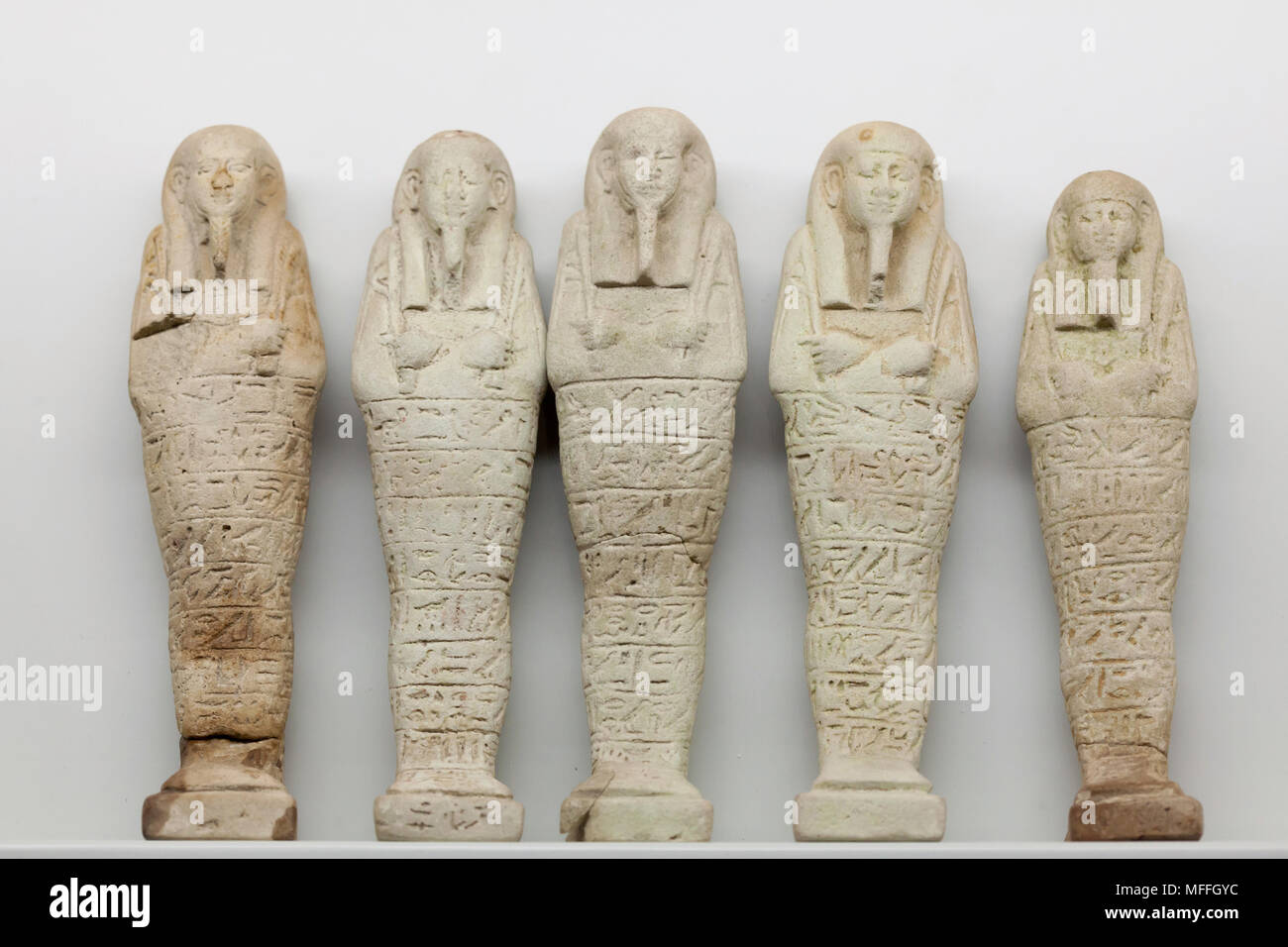 Ancient Egyptian ushabtis (funerary statuettes) of Herudja, son of Paunhatef, dated from the 26th Dynasty (664-525 BC) on display in the National Archaeological Museum (Museo Archeologico Nazionale di Napoli) in Naples, Campania, Italy. Stock Photohttps://www.alamy.com/image-license-details/?v=1https://www.alamy.com/ancient-egyptian-ushabtis-funerary-statuettes-of-herudja-son-of-paunhatef-dated-from-the-26th-dynasty-664-525-bc-on-display-in-the-national-archaeological-museum-museo-archeologico-nazionale-di-napoli-in-naples-campania-italy-image181666112.html
Ancient Egyptian ushabtis (funerary statuettes) of Herudja, son of Paunhatef, dated from the 26th Dynasty (664-525 BC) on display in the National Archaeological Museum (Museo Archeologico Nazionale di Napoli) in Naples, Campania, Italy. Stock Photohttps://www.alamy.com/image-license-details/?v=1https://www.alamy.com/ancient-egyptian-ushabtis-funerary-statuettes-of-herudja-son-of-paunhatef-dated-from-the-26th-dynasty-664-525-bc-on-display-in-the-national-archaeological-museum-museo-archeologico-nazionale-di-napoli-in-naples-campania-italy-image181666112.htmlRMMFFGYC–Ancient Egyptian ushabtis (funerary statuettes) of Herudja, son of Paunhatef, dated from the 26th Dynasty (664-525 BC) on display in the National Archaeological Museum (Museo Archeologico Nazionale di Napoli) in Naples, Campania, Italy.
 Egypt, Cairo, Egyptian Museum, from the tomb of Sennedjem, Deir el Medina : Ushabti box. Stock Photohttps://www.alamy.com/image-license-details/?v=1https://www.alamy.com/egypt-cairo-egyptian-museum-from-the-tomb-of-sennedjem-deir-el-medina-ushabti-box-image367855326.html
Egypt, Cairo, Egyptian Museum, from the tomb of Sennedjem, Deir el Medina : Ushabti box. Stock Photohttps://www.alamy.com/image-license-details/?v=1https://www.alamy.com/egypt-cairo-egyptian-museum-from-the-tomb-of-sennedjem-deir-el-medina-ushabti-box-image367855326.htmlRM2CAD766–Egypt, Cairo, Egyptian Museum, from the tomb of Sennedjem, Deir el Medina : Ushabti box.
 View of Egyptian Ushabtis figures. Ushabti (shabti or shawabti) is a funerary figurine used in ancient Egyptian religion. Stock Photohttps://www.alamy.com/image-license-details/?v=1https://www.alamy.com/view-of-egyptian-ushabtis-figures-ushabti-shabti-or-shawabti-is-a-funerary-figurine-used-in-ancient-egyptian-religion-image454986102.html
View of Egyptian Ushabtis figures. Ushabti (shabti or shawabti) is a funerary figurine used in ancient Egyptian religion. Stock Photohttps://www.alamy.com/image-license-details/?v=1https://www.alamy.com/view-of-egyptian-ushabtis-figures-ushabti-shabti-or-shawabti-is-a-funerary-figurine-used-in-ancient-egyptian-religion-image454986102.htmlRF2HC6BBJ–View of Egyptian Ushabtis figures. Ushabti (shabti or shawabti) is a funerary figurine used in ancient Egyptian religion.
 Ancient Egypt. Ushabti. Funerary figurine. Limestone. The State Hermitage Museum. Saint Petersburg. Russia. Stock Photohttps://www.alamy.com/image-license-details/?v=1https://www.alamy.com/stock-photo-ancient-egypt-ushabti-funerary-figurine-limestone-the-state-hermitage-106655347.html
Ancient Egypt. Ushabti. Funerary figurine. Limestone. The State Hermitage Museum. Saint Petersburg. Russia. Stock Photohttps://www.alamy.com/image-license-details/?v=1https://www.alamy.com/stock-photo-ancient-egypt-ushabti-funerary-figurine-limestone-the-state-hermitage-106655347.htmlRMG5EFYF–Ancient Egypt. Ushabti. Funerary figurine. Limestone. The State Hermitage Museum. Saint Petersburg. Russia.
 Ancient wooden Egyptian figures of Ptah Sokar Osiris in Istanbul Archaeology Museum, Turkey. Stock Photohttps://www.alamy.com/image-license-details/?v=1https://www.alamy.com/ancient-wooden-egyptian-figures-of-ptah-sokar-osiris-in-istanbul-archaeology-museum-turkey-image457409364.html
Ancient wooden Egyptian figures of Ptah Sokar Osiris in Istanbul Archaeology Museum, Turkey. Stock Photohttps://www.alamy.com/image-license-details/?v=1https://www.alamy.com/ancient-wooden-egyptian-figures-of-ptah-sokar-osiris-in-istanbul-archaeology-museum-turkey-image457409364.htmlRF2HG4P8M–Ancient wooden Egyptian figures of Ptah Sokar Osiris in Istanbul Archaeology Museum, Turkey.
 Italy Piedmont Turin Egyptian Museum This Shrine -Shaped ushabti or canonic- vase box was made for padihorpare, son of the Lady Stock Photohttps://www.alamy.com/image-license-details/?v=1https://www.alamy.com/stock-photo-italy-piedmont-turin-egyptian-museum-this-shrine-shaped-ushabti-or-73996131.html
Italy Piedmont Turin Egyptian Museum This Shrine -Shaped ushabti or canonic- vase box was made for padihorpare, son of the Lady Stock Photohttps://www.alamy.com/image-license-details/?v=1https://www.alamy.com/stock-photo-italy-piedmont-turin-egyptian-museum-this-shrine-shaped-ushabti-or-73996131.htmlRME8APPY–Italy Piedmont Turin Egyptian Museum This Shrine -Shaped ushabti or canonic- vase box was made for padihorpare, son of the Lady
 Wooden ushabtis funerary artifacts found in King Tutankhamun tomb Stock Photohttps://www.alamy.com/image-license-details/?v=1https://www.alamy.com/wooden-ushabtis-funerary-artifacts-found-in-king-tutankhamun-tomb-image485896336.html
Wooden ushabtis funerary artifacts found in King Tutankhamun tomb Stock Photohttps://www.alamy.com/image-license-details/?v=1https://www.alamy.com/wooden-ushabtis-funerary-artifacts-found-in-king-tutankhamun-tomb-image485896336.htmlRM2K6EDMG–Wooden ushabtis funerary artifacts found in King Tutankhamun tomb
 Ancient Egyptian Ushabti box, 664-332 BC, Thebes, painted wood. Louvre Museum N2697. Decoration: front side; the 4 sons of Horus (standing); isis : ta Stock Photohttps://www.alamy.com/image-license-details/?v=1https://www.alamy.com/ancient-egyptian-ushabti-box-664-332-bc-thebes-painted-wood-louvre-museum-n2697-decoration-front-side-the-4-sons-of-horus-standing-isis-ta-image450428782.html
Ancient Egyptian Ushabti box, 664-332 BC, Thebes, painted wood. Louvre Museum N2697. Decoration: front side; the 4 sons of Horus (standing); isis : ta Stock Photohttps://www.alamy.com/image-license-details/?v=1https://www.alamy.com/ancient-egyptian-ushabti-box-664-332-bc-thebes-painted-wood-louvre-museum-n2697-decoration-front-side-the-4-sons-of-horus-standing-isis-ta-image450428782.htmlRF2H4PPE6–Ancient Egyptian Ushabti box, 664-332 BC, Thebes, painted wood. Louvre Museum N2697. Decoration: front side; the 4 sons of Horus (standing); isis : ta
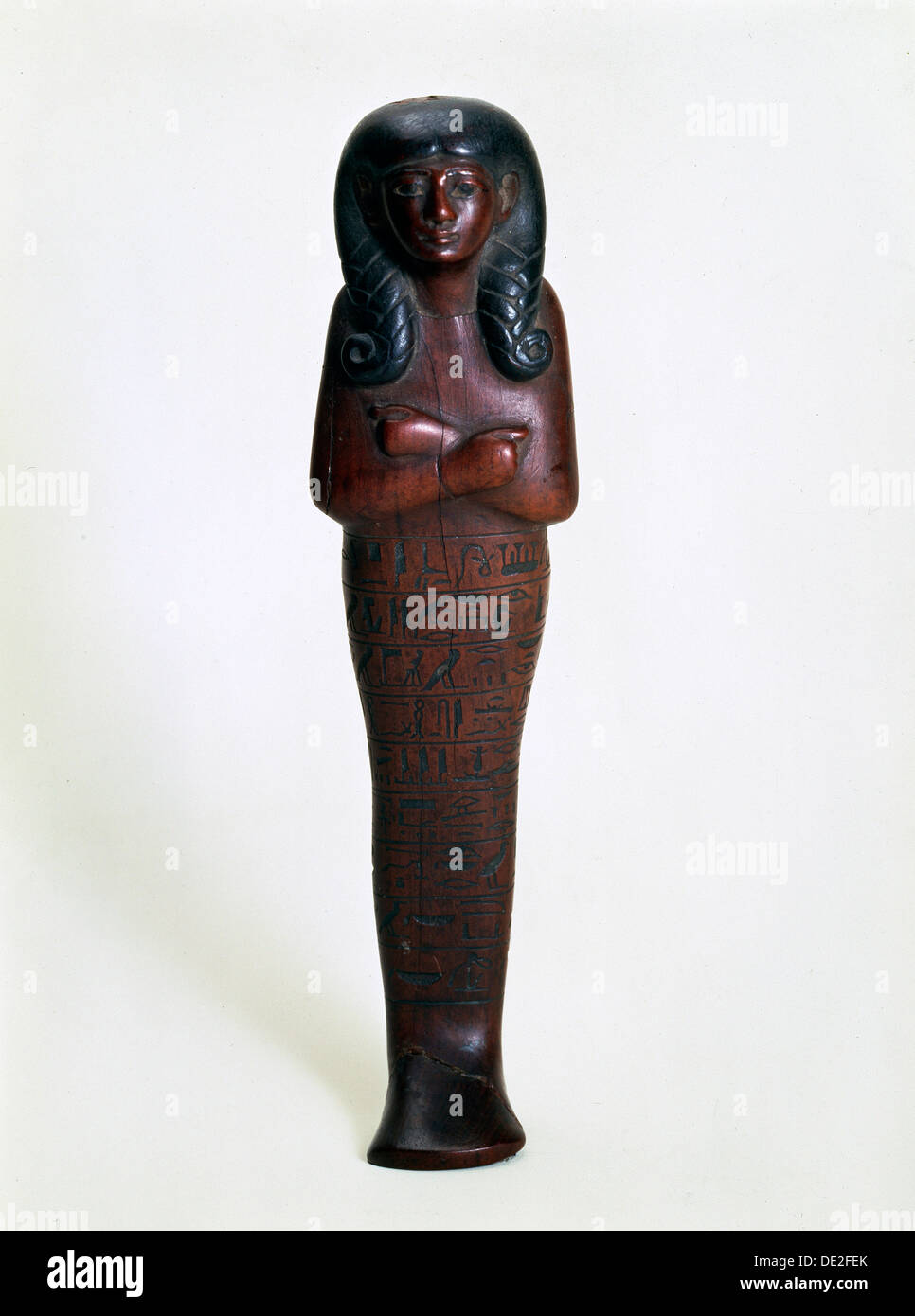 Wooden ushabti figurine of Mutry, Ancient Egyptian, 16th or 15th century BC. Artist: Unknown Stock Photohttps://www.alamy.com/image-license-details/?v=1https://www.alamy.com/wooden-ushabti-figurine-of-mutry-ancient-egyptian-16th-or-15th-century-image60292363.html
Wooden ushabti figurine of Mutry, Ancient Egyptian, 16th or 15th century BC. Artist: Unknown Stock Photohttps://www.alamy.com/image-license-details/?v=1https://www.alamy.com/wooden-ushabti-figurine-of-mutry-ancient-egyptian-16th-or-15th-century-image60292363.htmlRMDE2FEK–Wooden ushabti figurine of Mutry, Ancient Egyptian, 16th or 15th century BC. Artist: Unknown
 Egyptian Shabti Stock Photohttps://www.alamy.com/image-license-details/?v=1https://www.alamy.com/egyptian-shabti-image222998823.html
Egyptian Shabti Stock Photohttps://www.alamy.com/image-license-details/?v=1https://www.alamy.com/egyptian-shabti-image222998823.htmlRMPXPD7K–Egyptian Shabti
 An ancient, very worn Egyptian sshabti standing in sand. Shallow depth of field. Stock Photohttps://www.alamy.com/image-license-details/?v=1https://www.alamy.com/an-ancient-very-worn-egyptian-sshabti-standing-in-sand-shallow-depth-of-field-image383409610.html
An ancient, very worn Egyptian sshabti standing in sand. Shallow depth of field. Stock Photohttps://www.alamy.com/image-license-details/?v=1https://www.alamy.com/an-ancient-very-worn-egyptian-sshabti-standing-in-sand-shallow-depth-of-field-image383409610.htmlRF2D7NPTA–An ancient, very worn Egyptian sshabti standing in sand. Shallow depth of field.
 An Egyptian wooden ushabti,17th/18th Dynasty around 1500 B.C. Full figure carving with remnants of paint on the eyes and wig. Base peg on the bottom with a slightly trapezoidal wooden base. The Arabic number '1168' appears on the front of the base. Wood somewhat weathered,and there are two knot holes on the side of the figure. Total height: 36.5 cm. Comes from an old private collection in Bochum. ,historic,historical,ancient world,ancient world,ancient times,object,objects,stills,clipping,cut out,cut-out,cut-outs,mediterranean,precious metal,pr,Additional-Rights-Clearences-Not Available Stock Photohttps://www.alamy.com/image-license-details/?v=1https://www.alamy.com/stock-photo-an-egyptian-wooden-ushabti17th18th-dynasty-around-1500-bc-full-figure-51538588.html
An Egyptian wooden ushabti,17th/18th Dynasty around 1500 B.C. Full figure carving with remnants of paint on the eyes and wig. Base peg on the bottom with a slightly trapezoidal wooden base. The Arabic number '1168' appears on the front of the base. Wood somewhat weathered,and there are two knot holes on the side of the figure. Total height: 36.5 cm. Comes from an old private collection in Bochum. ,historic,historical,ancient world,ancient world,ancient times,object,objects,stills,clipping,cut out,cut-out,cut-outs,mediterranean,precious metal,pr,Additional-Rights-Clearences-Not Available Stock Photohttps://www.alamy.com/image-license-details/?v=1https://www.alamy.com/stock-photo-an-egyptian-wooden-ushabti17th18th-dynasty-around-1500-bc-full-figure-51538588.htmlRMCYRNYT–An Egyptian wooden ushabti,17th/18th Dynasty around 1500 B.C. Full figure carving with remnants of paint on the eyes and wig. Base peg on the bottom with a slightly trapezoidal wooden base. The Arabic number '1168' appears on the front of the base. Wood somewhat weathered,and there are two knot holes on the side of the figure. Total height: 36.5 cm. Comes from an old private collection in Bochum. ,historic,historical,ancient world,ancient world,ancient times,object,objects,stills,clipping,cut out,cut-out,cut-outs,mediterranean,precious metal,pr,Additional-Rights-Clearences-Not Available
 Egyptian Ushabti or Ushabti. The Ushabti also called Ushabti or shawabti, was an Ancient Egyptian funerary figurine Stock Photohttps://www.alamy.com/image-license-details/?v=1https://www.alamy.com/stock-photo-egyptian-ushabti-or-ushabti-the-ushabti-also-called-ushabti-or-shawabti-90838887.html
Egyptian Ushabti or Ushabti. The Ushabti also called Ushabti or shawabti, was an Ancient Egyptian funerary figurine Stock Photohttps://www.alamy.com/image-license-details/?v=1https://www.alamy.com/stock-photo-egyptian-ushabti-or-ushabti-the-ushabti-also-called-ushabti-or-shawabti-90838887.htmlRMF7P1WY–Egyptian Ushabti or Ushabti. The Ushabti also called Ushabti or shawabti, was an Ancient Egyptian funerary figurine
 Leiden, The Netherlands JAN 26, 2019: small ancient stone shabti mummiform figurines at the exhibition Gods of Egypt in Leiden. Funerary figurines. Stock Photohttps://www.alamy.com/image-license-details/?v=1https://www.alamy.com/leiden-the-netherlands-jan-26-2019-small-ancient-stone-shabti-mummiform-figurines-at-the-exhibition-gods-of-egypt-in-leiden-funerary-figurines-image362718193.html
Leiden, The Netherlands JAN 26, 2019: small ancient stone shabti mummiform figurines at the exhibition Gods of Egypt in Leiden. Funerary figurines. Stock Photohttps://www.alamy.com/image-license-details/?v=1https://www.alamy.com/leiden-the-netherlands-jan-26-2019-small-ancient-stone-shabti-mummiform-figurines-at-the-exhibition-gods-of-egypt-in-leiden-funerary-figurines-image362718193.htmlRF2C236N5–Leiden, The Netherlands JAN 26, 2019: small ancient stone shabti mummiform figurines at the exhibition Gods of Egypt in Leiden. Funerary figurines.
 Ancient Egyptian. Ushabti (Funerary Figurine) of Psamtek. 570 BC–526 BC. Egypt. Faience This figure was made of faience, a baked substance composed of ground quartz. The color was derived from copper oxides. Stock Photohttps://www.alamy.com/image-license-details/?v=1https://www.alamy.com/ancient-egyptian-ushabti-funerary-figurine-of-psamtek-570-bc526-bc-egypt-faience-this-figure-was-made-of-faience-a-baked-substance-composed-of-ground-quartz-the-color-was-derived-from-copper-oxides-image337972089.html
Ancient Egyptian. Ushabti (Funerary Figurine) of Psamtek. 570 BC–526 BC. Egypt. Faience This figure was made of faience, a baked substance composed of ground quartz. The color was derived from copper oxides. Stock Photohttps://www.alamy.com/image-license-details/?v=1https://www.alamy.com/ancient-egyptian-ushabti-funerary-figurine-of-psamtek-570-bc526-bc-egypt-faience-this-figure-was-made-of-faience-a-baked-substance-composed-of-ground-quartz-the-color-was-derived-from-copper-oxides-image337972089.htmlRM2AHRXRN–Ancient Egyptian. Ushabti (Funerary Figurine) of Psamtek. 570 BC–526 BC. Egypt. Faience This figure was made of faience, a baked substance composed of ground quartz. The color was derived from copper oxides.
 Berlin, New Museum, Uschebtikasten (New Museum, ushabti box) Uschebtis were often found in very large numbers in the graves because they were given as helpers to work in the afterlife for the deceased who lived there according to ancient Egyptian understanding. Stock Photohttps://www.alamy.com/image-license-details/?v=1https://www.alamy.com/stock-photo-berlin-new-museum-uschebtikasten-new-museum-ushabti-box-uschebtis-134984917.html
Berlin, New Museum, Uschebtikasten (New Museum, ushabti box) Uschebtis were often found in very large numbers in the graves because they were given as helpers to work in the afterlife for the deceased who lived there according to ancient Egyptian understanding. Stock Photohttps://www.alamy.com/image-license-details/?v=1https://www.alamy.com/stock-photo-berlin-new-museum-uschebtikasten-new-museum-ushabti-box-uschebtis-134984917.htmlRMHRH2HW–Berlin, New Museum, Uschebtikasten (New Museum, ushabti box) Uschebtis were often found in very large numbers in the graves because they were given as helpers to work in the afterlife for the deceased who lived there according to ancient Egyptian understanding.
 Ushabti (Funerary Figurine) of Psamtek. Egyptian. Date: 570 BC-526 BC. Dimensions: 18.4 × 7.1 × 3.8 cm (7 1/8 × 2 7/8 × 1 1/2 in.). Faience. Origin: Egypt. Museum: The Chicago Art Institute. Author: Ancient Egyptian. Stock Photohttps://www.alamy.com/image-license-details/?v=1https://www.alamy.com/ushabti-funerary-figurine-of-psamtek-egyptian-date-570-bc-526-bc-dimensions-184-71-38-cm-7-18-2-78-1-12-in-faience-origin-egypt-museum-the-chicago-art-institute-author-ancient-egyptian-image239825677.html
Ushabti (Funerary Figurine) of Psamtek. Egyptian. Date: 570 BC-526 BC. Dimensions: 18.4 × 7.1 × 3.8 cm (7 1/8 × 2 7/8 × 1 1/2 in.). Faience. Origin: Egypt. Museum: The Chicago Art Institute. Author: Ancient Egyptian. Stock Photohttps://www.alamy.com/image-license-details/?v=1https://www.alamy.com/ushabti-funerary-figurine-of-psamtek-egyptian-date-570-bc-526-bc-dimensions-184-71-38-cm-7-18-2-78-1-12-in-faience-origin-egypt-museum-the-chicago-art-institute-author-ancient-egyptian-image239825677.htmlRMRX502N–Ushabti (Funerary Figurine) of Psamtek. Egyptian. Date: 570 BC-526 BC. Dimensions: 18.4 × 7.1 × 3.8 cm (7 1/8 × 2 7/8 × 1 1/2 in.). Faience. Origin: Egypt. Museum: The Chicago Art Institute. Author: Ancient Egyptian.
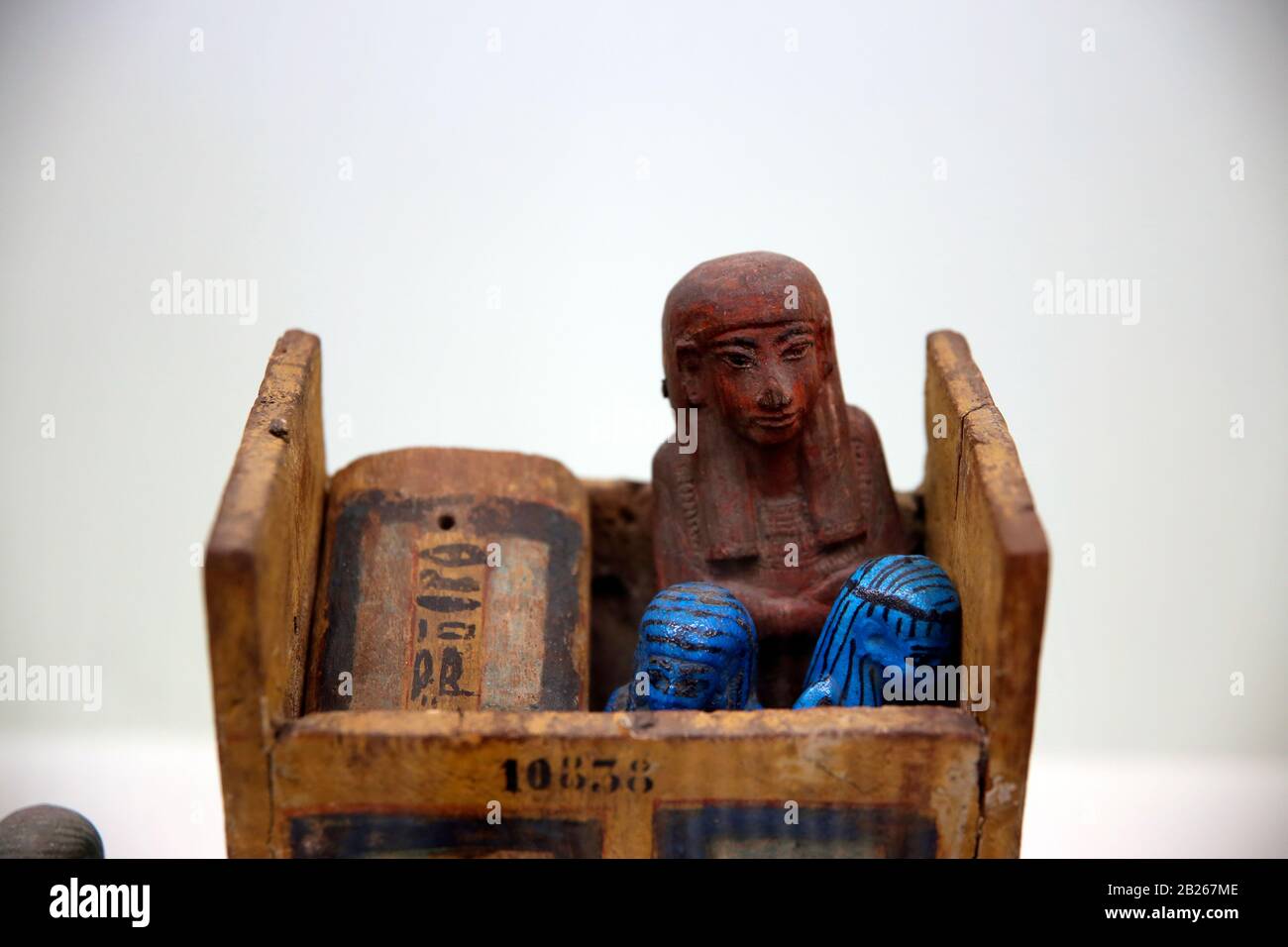 Egypt. Wooden chests with Ushabti placed in the graves together with the dead. Istanbul Archaeological Museum, Turkey. Stock Photohttps://www.alamy.com/image-license-details/?v=1https://www.alamy.com/egypt-wooden-chests-with-ushabti-placed-in-the-graves-together-with-the-dead-istanbul-archaeological-museum-turkey-image345574446.html
Egypt. Wooden chests with Ushabti placed in the graves together with the dead. Istanbul Archaeological Museum, Turkey. Stock Photohttps://www.alamy.com/image-license-details/?v=1https://www.alamy.com/egypt-wooden-chests-with-ushabti-placed-in-the-graves-together-with-the-dead-istanbul-archaeological-museum-turkey-image345574446.htmlRM2B267ME–Egypt. Wooden chests with Ushabti placed in the graves together with the dead. Istanbul Archaeological Museum, Turkey.
 Tutankhamuns Tomb treasure, Gilded wooden figure of the Protector God Sened, from the tomb of Tutankhamun, Pharaoh, Ancient Egypt Stock Photohttps://www.alamy.com/image-license-details/?v=1https://www.alamy.com/tutankhamuns-tomb-treasure-gilded-wooden-figure-of-the-protector-god-sened-from-the-tomb-of-tutankhamun-pharaoh-ancient-egypt-image349175141.html
Tutankhamuns Tomb treasure, Gilded wooden figure of the Protector God Sened, from the tomb of Tutankhamun, Pharaoh, Ancient Egypt Stock Photohttps://www.alamy.com/image-license-details/?v=1https://www.alamy.com/tutankhamuns-tomb-treasure-gilded-wooden-figure-of-the-protector-god-sened-from-the-tomb-of-tutankhamun-pharaoh-ancient-egypt-image349175141.htmlRM2B828CN–Tutankhamuns Tomb treasure, Gilded wooden figure of the Protector God Sened, from the tomb of Tutankhamun, Pharaoh, Ancient Egypt
 Ancient Egyptian ushabtis (funerary statuettes) of Herugia, born of Asetemhat, dated from the 28th to the 30th Dynasty (404-332 BC) found in Giza on display in the National Archaeological Museum (Museo Archeologico Nazionale di Napoli) in Naples, Campania, Italy. Stock Photohttps://www.alamy.com/image-license-details/?v=1https://www.alamy.com/ancient-egyptian-ushabtis-funerary-statuettes-of-herugia-born-of-asetemhat-dated-from-the-28th-to-the-30th-dynasty-404-332-bc-found-in-giza-on-display-in-the-national-archaeological-museum-museo-archeologico-nazionale-di-napoli-in-naples-campania-italy-image181694162.html
Ancient Egyptian ushabtis (funerary statuettes) of Herugia, born of Asetemhat, dated from the 28th to the 30th Dynasty (404-332 BC) found in Giza on display in the National Archaeological Museum (Museo Archeologico Nazionale di Napoli) in Naples, Campania, Italy. Stock Photohttps://www.alamy.com/image-license-details/?v=1https://www.alamy.com/ancient-egyptian-ushabtis-funerary-statuettes-of-herugia-born-of-asetemhat-dated-from-the-28th-to-the-30th-dynasty-404-332-bc-found-in-giza-on-display-in-the-national-archaeological-museum-museo-archeologico-nazionale-di-napoli-in-naples-campania-italy-image181694162.htmlRMMFGTN6–Ancient Egyptian ushabtis (funerary statuettes) of Herugia, born of Asetemhat, dated from the 28th to the 30th Dynasty (404-332 BC) found in Giza on display in the National Archaeological Museum (Museo Archeologico Nazionale di Napoli) in Naples, Campania, Italy.
 Ancient Egypt. Funerary servants figures ushabtis. Vatican Museums. Stock Photohttps://www.alamy.com/image-license-details/?v=1https://www.alamy.com/stock-photo-ancient-egypt-funerary-servants-figures-ushabtis-vatican-museums-83289723.html
Ancient Egypt. Funerary servants figures ushabtis. Vatican Museums. Stock Photohttps://www.alamy.com/image-license-details/?v=1https://www.alamy.com/stock-photo-ancient-egypt-funerary-servants-figures-ushabtis-vatican-museums-83289723.htmlRMERE4TY–Ancient Egypt. Funerary servants figures ushabtis. Vatican Museums.
 Egypt, Cairo, Egyptian Museum, from the tomb of Sennedjem, Deir el Medina : Ushebti of Rosu, one of the wives of the father of Sennedjem. Stock Photohttps://www.alamy.com/image-license-details/?v=1https://www.alamy.com/egypt-cairo-egyptian-museum-from-the-tomb-of-sennedjem-deir-el-medina-ushebti-of-rosu-one-of-the-wives-of-the-father-of-sennedjem-image352262537.html
Egypt, Cairo, Egyptian Museum, from the tomb of Sennedjem, Deir el Medina : Ushebti of Rosu, one of the wives of the father of Sennedjem. Stock Photohttps://www.alamy.com/image-license-details/?v=1https://www.alamy.com/egypt-cairo-egyptian-museum-from-the-tomb-of-sennedjem-deir-el-medina-ushebti-of-rosu-one-of-the-wives-of-the-father-of-sennedjem-image352262537.htmlRM2BD2XCW–Egypt, Cairo, Egyptian Museum, from the tomb of Sennedjem, Deir el Medina : Ushebti of Rosu, one of the wives of the father of Sennedjem.
 Egypt. Ushabti. (also called shabti). Funerary figurine, placed in tombs. Istanbul Archaeological Museum, Turkey. Stock Photohttps://www.alamy.com/image-license-details/?v=1https://www.alamy.com/egypt-ushabti-also-called-shabti-funerary-figurine-placed-in-tombs-istanbul-archaeological-museum-turkey-image345573517.html
Egypt. Ushabti. (also called shabti). Funerary figurine, placed in tombs. Istanbul Archaeological Museum, Turkey. Stock Photohttps://www.alamy.com/image-license-details/?v=1https://www.alamy.com/egypt-ushabti-also-called-shabti-funerary-figurine-placed-in-tombs-istanbul-archaeological-museum-turkey-image345573517.htmlRM2B266F9–Egypt. Ushabti. (also called shabti). Funerary figurine, placed in tombs. Istanbul Archaeological Museum, Turkey.
 Egypt, Cairo, Egyptian Museum, funeral material found in the royal necropolis of Tanis : Ushabtis of prince Hornakht. Stock Photohttps://www.alamy.com/image-license-details/?v=1https://www.alamy.com/egypt-cairo-egyptian-museum-funeral-material-found-in-the-royal-necropolis-of-tanis-ushabtis-of-prince-hornakht-image368047714.html
Egypt, Cairo, Egyptian Museum, funeral material found in the royal necropolis of Tanis : Ushabtis of prince Hornakht. Stock Photohttps://www.alamy.com/image-license-details/?v=1https://www.alamy.com/egypt-cairo-egyptian-museum-funeral-material-found-in-the-royal-necropolis-of-tanis-ushabtis-of-prince-hornakht-image368047714.htmlRM2CAP0H6–Egypt, Cairo, Egyptian Museum, funeral material found in the royal necropolis of Tanis : Ushabtis of prince Hornakht.
 Egypt. Ushabti. Funerary figurines of limestone and wood. 14th century BC. New Kingdom. The State Hermitage Museum. Saint Petersburg. Russia. Stock Photohttps://www.alamy.com/image-license-details/?v=1https://www.alamy.com/stock-photo-egypt-ushabti-funerary-figurines-of-limestone-and-wood-14th-century-105224496.html
Egypt. Ushabti. Funerary figurines of limestone and wood. 14th century BC. New Kingdom. The State Hermitage Museum. Saint Petersburg. Russia. Stock Photohttps://www.alamy.com/image-license-details/?v=1https://www.alamy.com/stock-photo-egypt-ushabti-funerary-figurines-of-limestone-and-wood-14th-century-105224496.htmlRMG35AWM–Egypt. Ushabti. Funerary figurines of limestone and wood. 14th century BC. New Kingdom. The State Hermitage Museum. Saint Petersburg. Russia.
 Wooden ushabtis funerary artifacts found in King Tutankhamun tomb Stock Photohttps://www.alamy.com/image-license-details/?v=1https://www.alamy.com/wooden-ushabtis-funerary-artifacts-found-in-king-tutankhamun-tomb-image485896334.html
Wooden ushabtis funerary artifacts found in King Tutankhamun tomb Stock Photohttps://www.alamy.com/image-license-details/?v=1https://www.alamy.com/wooden-ushabtis-funerary-artifacts-found-in-king-tutankhamun-tomb-image485896334.htmlRM2K6EDME–Wooden ushabtis funerary artifacts found in King Tutankhamun tomb
 Ancient Egyptian Ushabti box, 664-332 BC, Thebes, painted wood. Louvre Museum N2697. Decoration: front side; the 4 sons of Horus (standing); isis : ta Stock Photohttps://www.alamy.com/image-license-details/?v=1https://www.alamy.com/ancient-egyptian-ushabti-box-664-332-bc-thebes-painted-wood-louvre-museum-n2697-decoration-front-side-the-4-sons-of-horus-standing-isis-ta-image450433833.html
Ancient Egyptian Ushabti box, 664-332 BC, Thebes, painted wood. Louvre Museum N2697. Decoration: front side; the 4 sons of Horus (standing); isis : ta Stock Photohttps://www.alamy.com/image-license-details/?v=1https://www.alamy.com/ancient-egyptian-ushabti-box-664-332-bc-thebes-painted-wood-louvre-museum-n2697-decoration-front-side-the-4-sons-of-horus-standing-isis-ta-image450433833.htmlRF2H4R0XH–Ancient Egyptian Ushabti box, 664-332 BC, Thebes, painted wood. Louvre Museum N2697. Decoration: front side; the 4 sons of Horus (standing); isis : ta
 Egyptian funerary figures ushabtis, Memphis, 500 BC at the Louvre Museum, Paris, France Stock Photohttps://www.alamy.com/image-license-details/?v=1https://www.alamy.com/stock-photo-egyptian-funerary-figures-ushabtis-memphis-500-bc-at-the-louvre-museum-72448603.html
Egyptian funerary figures ushabtis, Memphis, 500 BC at the Louvre Museum, Paris, France Stock Photohttps://www.alamy.com/image-license-details/?v=1https://www.alamy.com/stock-photo-egyptian-funerary-figures-ushabtis-memphis-500-bc-at-the-louvre-museum-72448603.htmlRME5T8X3–Egyptian funerary figures ushabtis, Memphis, 500 BC at the Louvre Museum, Paris, France
 Ushabti Figure. A view of the inscription on the base. The Treasures of Tutankhamen, The Exhibition Catalogue by I E S Edwards, page 83. Stock Photohttps://www.alamy.com/image-license-details/?v=1https://www.alamy.com/ushabti-figure-a-view-of-the-inscription-on-the-base-the-treasures-of-tutankhamen-the-exhibition-catalogue-by-i-e-s-edwards-page-83-image268793726.html
Ushabti Figure. A view of the inscription on the base. The Treasures of Tutankhamen, The Exhibition Catalogue by I E S Edwards, page 83. Stock Photohttps://www.alamy.com/image-license-details/?v=1https://www.alamy.com/ushabti-figure-a-view-of-the-inscription-on-the-base-the-treasures-of-tutankhamen-the-exhibition-catalogue-by-i-e-s-edwards-page-83-image268793726.htmlRMWH8H3X–Ushabti Figure. A view of the inscription on the base. The Treasures of Tutankhamen, The Exhibition Catalogue by I E S Edwards, page 83.
 Ushabti of Tutankhamun, showning king wearing the red crown of the North, from the tomb of the pharaoh Tutankhamun Stock Photohttps://www.alamy.com/image-license-details/?v=1https://www.alamy.com/stock-photo-ushabti-of-tutankhamun-showning-king-wearing-the-red-crown-of-the-16082248.html
Ushabti of Tutankhamun, showning king wearing the red crown of the North, from the tomb of the pharaoh Tutankhamun Stock Photohttps://www.alamy.com/image-license-details/?v=1https://www.alamy.com/stock-photo-ushabti-of-tutankhamun-showning-king-wearing-the-red-crown-of-the-16082248.htmlRMARM2EH–Ushabti of Tutankhamun, showning king wearing the red crown of the North, from the tomb of the pharaoh Tutankhamun
 geography/travel, Egypt, death cult, canopic jar for shabti, painted clay, 1300 - 1200 BC, 19th dynasty, State Collection of Egyptian Art, Munich, Hapi, Imsety, ancient world, ushabti, fine arts, historic, historical, ancient world, Stock Photohttps://www.alamy.com/image-license-details/?v=1https://www.alamy.com/stock-photo-geographytravel-egypt-death-cult-canopic-jar-for-shabti-painted-clay-12825259.html
geography/travel, Egypt, death cult, canopic jar for shabti, painted clay, 1300 - 1200 BC, 19th dynasty, State Collection of Egyptian Art, Munich, Hapi, Imsety, ancient world, ushabti, fine arts, historic, historical, ancient world, Stock Photohttps://www.alamy.com/image-license-details/?v=1https://www.alamy.com/stock-photo-geographytravel-egypt-death-cult-canopic-jar-for-shabti-painted-clay-12825259.htmlRMAB9W2M–geography/travel, Egypt, death cult, canopic jar for shabti, painted clay, 1300 - 1200 BC, 19th dynasty, State Collection of Egyptian Art, Munich, Hapi, Imsety, ancient world, ushabti, fine arts, historic, historical, ancient world,
 Egyptian Ushabti or Ushabti. The Ushabti also called Ushabti or shawabti, was an Ancient Egyptian funerary figurine Stock Photohttps://www.alamy.com/image-license-details/?v=1https://www.alamy.com/stock-photo-egyptian-ushabti-or-ushabti-the-ushabti-also-called-ushabti-or-shawabti-90838896.html
Egyptian Ushabti or Ushabti. The Ushabti also called Ushabti or shawabti, was an Ancient Egyptian funerary figurine Stock Photohttps://www.alamy.com/image-license-details/?v=1https://www.alamy.com/stock-photo-egyptian-ushabti-or-ushabti-the-ushabti-also-called-ushabti-or-shawabti-90838896.htmlRMF7P1X8–Egyptian Ushabti or Ushabti. The Ushabti also called Ushabti or shawabti, was an Ancient Egyptian funerary figurine
 Shabti Figures Carved From Limestone Stock Photohttps://www.alamy.com/image-license-details/?v=1https://www.alamy.com/stock-photo-shabti-figures-carved-from-limestone-36971085.html
Shabti Figures Carved From Limestone Stock Photohttps://www.alamy.com/image-license-details/?v=1https://www.alamy.com/stock-photo-shabti-figures-carved-from-limestone-36971085.htmlRMC444YW–Shabti Figures Carved From Limestone
 English: Ushabti of Minmose, an ancient Egyptian high officer under the pharaoh Amenhotep II. 18th Dynasty, New Kingdom. 14 May 2014, 20:06:37 79 Ushabti Minmose Petrie Stock Photohttps://www.alamy.com/image-license-details/?v=1https://www.alamy.com/english-ushabti-of-minmose-an-ancient-egyptian-high-officer-under-the-pharaoh-amenhotep-ii-18th-dynasty-new-kingdom-14-may-2014-200637-79-ushabti-minmose-petrie-image210503936.html
English: Ushabti of Minmose, an ancient Egyptian high officer under the pharaoh Amenhotep II. 18th Dynasty, New Kingdom. 14 May 2014, 20:06:37 79 Ushabti Minmose Petrie Stock Photohttps://www.alamy.com/image-license-details/?v=1https://www.alamy.com/english-ushabti-of-minmose-an-ancient-egyptian-high-officer-under-the-pharaoh-amenhotep-ii-18th-dynasty-new-kingdom-14-may-2014-200637-79-ushabti-minmose-petrie-image210503936.htmlRMP6D7WM–English: Ushabti of Minmose, an ancient Egyptian high officer under the pharaoh Amenhotep II. 18th Dynasty, New Kingdom. 14 May 2014, 20:06:37 79 Ushabti Minmose Petrie
 Berlin, New Museum, Uschebtikasten (New Museum, ushabti box) Uschebtis were often found in very large numbers in the graves because they were given as helpers to work in the afterlife for the deceased who lived there according to ancient Egyptian understanding. Stock Photohttps://www.alamy.com/image-license-details/?v=1https://www.alamy.com/stock-photo-berlin-new-museum-uschebtikasten-new-museum-ushabti-box-uschebtis-134945121.html
Berlin, New Museum, Uschebtikasten (New Museum, ushabti box) Uschebtis were often found in very large numbers in the graves because they were given as helpers to work in the afterlife for the deceased who lived there according to ancient Egyptian understanding. Stock Photohttps://www.alamy.com/image-license-details/?v=1https://www.alamy.com/stock-photo-berlin-new-museum-uschebtikasten-new-museum-ushabti-box-uschebtis-134945121.htmlRMHRF7TH–Berlin, New Museum, Uschebtikasten (New Museum, ushabti box) Uschebtis were often found in very large numbers in the graves because they were given as helpers to work in the afterlife for the deceased who lived there according to ancient Egyptian understanding.
 Ushabti (Funerary Figurine) of Horudja. Egyptian; Hawara. Date: 380 BC-343 BC. Dimensions: 21.9 × 6.6 × 4.7 cm (8 5/8 × 2 5/8 × 1 7/8 in.). Faience. Origin: Egypt. Museum: The Chicago Art Institute. Author: Ancient Egyptian. Stock Photohttps://www.alamy.com/image-license-details/?v=1https://www.alamy.com/ushabti-funerary-figurine-of-horudja-egyptian-hawara-date-380-bc-343-bc-dimensions-219-66-47-cm-8-58-2-58-1-78-in-faience-origin-egypt-museum-the-chicago-art-institute-author-ancient-egyptian-image239826865.html
Ushabti (Funerary Figurine) of Horudja. Egyptian; Hawara. Date: 380 BC-343 BC. Dimensions: 21.9 × 6.6 × 4.7 cm (8 5/8 × 2 5/8 × 1 7/8 in.). Faience. Origin: Egypt. Museum: The Chicago Art Institute. Author: Ancient Egyptian. Stock Photohttps://www.alamy.com/image-license-details/?v=1https://www.alamy.com/ushabti-funerary-figurine-of-horudja-egyptian-hawara-date-380-bc-343-bc-dimensions-219-66-47-cm-8-58-2-58-1-78-in-faience-origin-egypt-museum-the-chicago-art-institute-author-ancient-egyptian-image239826865.htmlRMRX51H5–Ushabti (Funerary Figurine) of Horudja. Egyptian; Hawara. Date: 380 BC-343 BC. Dimensions: 21.9 × 6.6 × 4.7 cm (8 5/8 × 2 5/8 × 1 7/8 in.). Faience. Origin: Egypt. Museum: The Chicago Art Institute. Author: Ancient Egyptian.
 Ptah Sokar Osiris figure (Ancient Egypt artifacts) in Istanbul Archaeology Museum, Turkey. Stock Photohttps://www.alamy.com/image-license-details/?v=1https://www.alamy.com/ptah-sokar-osiris-figure-ancient-egypt-artifacts-in-istanbul-archaeology-museum-turkey-image457524245.html
Ptah Sokar Osiris figure (Ancient Egypt artifacts) in Istanbul Archaeology Museum, Turkey. Stock Photohttps://www.alamy.com/image-license-details/?v=1https://www.alamy.com/ptah-sokar-osiris-figure-ancient-egypt-artifacts-in-istanbul-archaeology-museum-turkey-image457524245.htmlRF2HGA0RH–Ptah Sokar Osiris figure (Ancient Egypt artifacts) in Istanbul Archaeology Museum, Turkey.
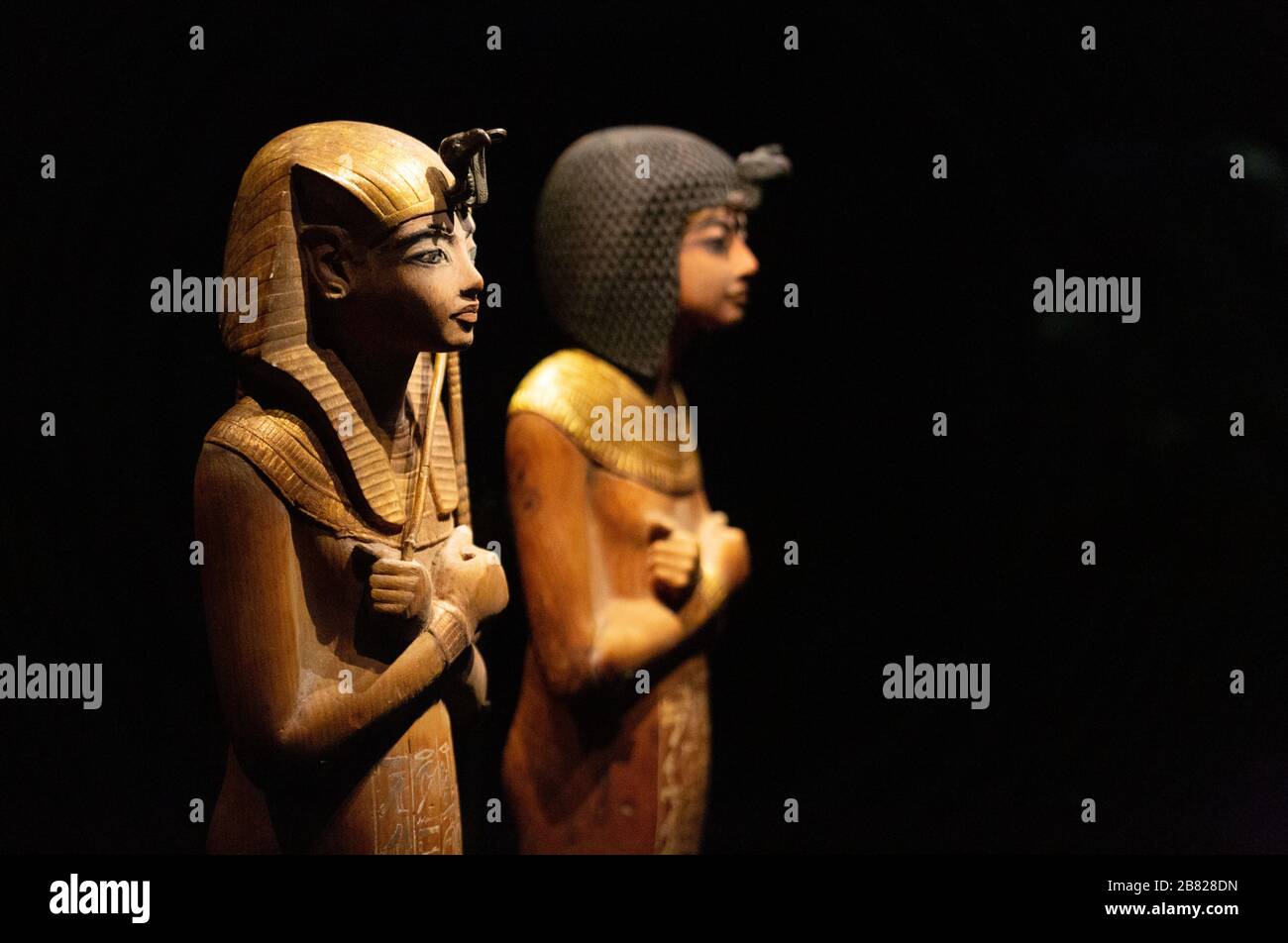 Tutankhamun tomb treasures; painted wooden shabtis, or figurines wearing Nemes Headdress and Nubian Wig, from Ancient Egypt Stock Photohttps://www.alamy.com/image-license-details/?v=1https://www.alamy.com/tutankhamun-tomb-treasures-painted-wooden-shabtis-or-figurines-wearing-nemes-headdress-and-nubian-wig-from-ancient-egypt-image349175169.html
Tutankhamun tomb treasures; painted wooden shabtis, or figurines wearing Nemes Headdress and Nubian Wig, from Ancient Egypt Stock Photohttps://www.alamy.com/image-license-details/?v=1https://www.alamy.com/tutankhamun-tomb-treasures-painted-wooden-shabtis-or-figurines-wearing-nemes-headdress-and-nubian-wig-from-ancient-egypt-image349175169.htmlRM2B828DN–Tutankhamun tomb treasures; painted wooden shabtis, or figurines wearing Nemes Headdress and Nubian Wig, from Ancient Egypt
 Ancient Egyptian ushabtis (funerary statuettes) of Herugia, born of Asetemhat, dated from the 28th to the 30th Dynasty (404-332 BC) found in Giza on display in the National Archaeological Museum (Museo Archeologico Nazionale di Napoli) in Naples, Campania, Italy. Stock Photohttps://www.alamy.com/image-license-details/?v=1https://www.alamy.com/ancient-egyptian-ushabtis-funerary-statuettes-of-herugia-born-of-asetemhat-dated-from-the-28th-to-the-30th-dynasty-404-332-bc-found-in-giza-on-display-in-the-national-archaeological-museum-museo-archeologico-nazionale-di-napoli-in-naples-campania-italy-image181667164.html
Ancient Egyptian ushabtis (funerary statuettes) of Herugia, born of Asetemhat, dated from the 28th to the 30th Dynasty (404-332 BC) found in Giza on display in the National Archaeological Museum (Museo Archeologico Nazionale di Napoli) in Naples, Campania, Italy. Stock Photohttps://www.alamy.com/image-license-details/?v=1https://www.alamy.com/ancient-egyptian-ushabtis-funerary-statuettes-of-herugia-born-of-asetemhat-dated-from-the-28th-to-the-30th-dynasty-404-332-bc-found-in-giza-on-display-in-the-national-archaeological-museum-museo-archeologico-nazionale-di-napoli-in-naples-campania-italy-image181667164.htmlRMMFFJ90–Ancient Egyptian ushabtis (funerary statuettes) of Herugia, born of Asetemhat, dated from the 28th to the 30th Dynasty (404-332 BC) found in Giza on display in the National Archaeological Museum (Museo Archeologico Nazionale di Napoli) in Naples, Campania, Italy.
 Cairo, Egypt. 17th Nov, 2020. Ushabti statuettes are seen at the Egyptian Museum in Cairo, Egypt, on Nov. 17, 2020. Egypt celebrated on Tuesday the 118th anniversary of the establishment of the Egyptian Museum located in downtown Cairo, which is home to an extensive collection of ancient Egyptian antiquities. Credit: Ahmed Gomaa/Xinhua/Alamy Live News Stock Photohttps://www.alamy.com/image-license-details/?v=1https://www.alamy.com/cairo-egypt-17th-nov-2020-ushabti-statuettes-are-seen-at-the-egyptian-museum-in-cairo-egypt-on-nov-17-2020-egypt-celebrated-on-tuesday-the-118th-anniversary-of-the-establishment-of-the-egyptian-museum-located-in-downtown-cairo-which-is-home-to-an-extensive-collection-of-ancient-egyptian-antiquities-credit-ahmed-gomaaxinhuaalamy-live-news-image386007716.html
Cairo, Egypt. 17th Nov, 2020. Ushabti statuettes are seen at the Egyptian Museum in Cairo, Egypt, on Nov. 17, 2020. Egypt celebrated on Tuesday the 118th anniversary of the establishment of the Egyptian Museum located in downtown Cairo, which is home to an extensive collection of ancient Egyptian antiquities. Credit: Ahmed Gomaa/Xinhua/Alamy Live News Stock Photohttps://www.alamy.com/image-license-details/?v=1https://www.alamy.com/cairo-egypt-17th-nov-2020-ushabti-statuettes-are-seen-at-the-egyptian-museum-in-cairo-egypt-on-nov-17-2020-egypt-celebrated-on-tuesday-the-118th-anniversary-of-the-establishment-of-the-egyptian-museum-located-in-downtown-cairo-which-is-home-to-an-extensive-collection-of-ancient-egyptian-antiquities-credit-ahmed-gomaaxinhuaalamy-live-news-image386007716.htmlRM2DC04NT–Cairo, Egypt. 17th Nov, 2020. Ushabti statuettes are seen at the Egyptian Museum in Cairo, Egypt, on Nov. 17, 2020. Egypt celebrated on Tuesday the 118th anniversary of the establishment of the Egyptian Museum located in downtown Cairo, which is home to an extensive collection of ancient Egyptian antiquities. Credit: Ahmed Gomaa/Xinhua/Alamy Live News
 Detail from a decorated Egyptian shabti box (or ushabti box) from Late Period (664 - 332 BC) at the Louvre Museum, Paris, France Stock Photohttps://www.alamy.com/image-license-details/?v=1https://www.alamy.com/stock-photo-detail-from-a-decorated-egyptian-shabti-box-or-ushabti-box-from-late-122668131.html
Detail from a decorated Egyptian shabti box (or ushabti box) from Late Period (664 - 332 BC) at the Louvre Museum, Paris, France Stock Photohttps://www.alamy.com/image-license-details/?v=1https://www.alamy.com/stock-photo-detail-from-a-decorated-egyptian-shabti-box-or-ushabti-box-from-late-122668131.htmlRMH3G0CK–Detail from a decorated Egyptian shabti box (or ushabti box) from Late Period (664 - 332 BC) at the Louvre Museum, Paris, France
 Egypt. Ushabti. (also called shabti). Funerary figurine, placed in tombs. Istanbul Archaeological Museum, Turkey. Stock Photohttps://www.alamy.com/image-license-details/?v=1https://www.alamy.com/egypt-ushabti-also-called-shabti-funerary-figurine-placed-in-tombs-istanbul-archaeological-museum-turkey-image345573513.html
Egypt. Ushabti. (also called shabti). Funerary figurine, placed in tombs. Istanbul Archaeological Museum, Turkey. Stock Photohttps://www.alamy.com/image-license-details/?v=1https://www.alamy.com/egypt-ushabti-also-called-shabti-funerary-figurine-placed-in-tombs-istanbul-archaeological-museum-turkey-image345573513.htmlRM2B266F5–Egypt. Ushabti. (also called shabti). Funerary figurine, placed in tombs. Istanbul Archaeological Museum, Turkey.
 Egypt, Cairo, Egyptian Museum, funeral material found in the royal necropolis of Tanis : Ushabtis of prince Hornakht. Stock Photohttps://www.alamy.com/image-license-details/?v=1https://www.alamy.com/egypt-cairo-egyptian-museum-funeral-material-found-in-the-royal-necropolis-of-tanis-ushabtis-of-prince-hornakht-image368076579.html
Egypt, Cairo, Egyptian Museum, funeral material found in the royal necropolis of Tanis : Ushabtis of prince Hornakht. Stock Photohttps://www.alamy.com/image-license-details/?v=1https://www.alamy.com/egypt-cairo-egyptian-museum-funeral-material-found-in-the-royal-necropolis-of-tanis-ushabtis-of-prince-hornakht-image368076579.htmlRM2CAR9C3–Egypt, Cairo, Egyptian Museum, funeral material found in the royal necropolis of Tanis : Ushabtis of prince Hornakht.
 Minya, Egypt. 30th Jan, 2020. Newly discovered ushabti statuettes are seen in Province of Minya, Egypt, on Jan. 30, 2020. The Egyptian Ministry of Tourism and Antiquities announced on Thursday the discovery of 16 ancient tombs with about 20 sarcophagi and thousands of funerary objects at a necropolis in Upper Egypt's Province of Minya. Credit: Wu Huiwo/Xinhua/Alamy Live News Stock Photohttps://www.alamy.com/image-license-details/?v=1https://www.alamy.com/minya-egypt-30th-jan-2020-newly-discovered-ushabti-statuettes-are-seen-in-province-of-minya-egypt-on-jan-30-2020-the-egyptian-ministry-of-tourism-and-antiquities-announced-on-thursday-the-discovery-of-16-ancient-tombs-with-about-20-sarcophagi-and-thousands-of-funerary-objects-at-a-necropolis-in-upper-egypts-province-of-minya-credit-wu-huiwoxinhuaalamy-live-news-image341895119.html
Minya, Egypt. 30th Jan, 2020. Newly discovered ushabti statuettes are seen in Province of Minya, Egypt, on Jan. 30, 2020. The Egyptian Ministry of Tourism and Antiquities announced on Thursday the discovery of 16 ancient tombs with about 20 sarcophagi and thousands of funerary objects at a necropolis in Upper Egypt's Province of Minya. Credit: Wu Huiwo/Xinhua/Alamy Live News Stock Photohttps://www.alamy.com/image-license-details/?v=1https://www.alamy.com/minya-egypt-30th-jan-2020-newly-discovered-ushabti-statuettes-are-seen-in-province-of-minya-egypt-on-jan-30-2020-the-egyptian-ministry-of-tourism-and-antiquities-announced-on-thursday-the-discovery-of-16-ancient-tombs-with-about-20-sarcophagi-and-thousands-of-funerary-objects-at-a-necropolis-in-upper-egypts-province-of-minya-credit-wu-huiwoxinhuaalamy-live-news-image341895119.htmlRM2AT6JKY–Minya, Egypt. 30th Jan, 2020. Newly discovered ushabti statuettes are seen in Province of Minya, Egypt, on Jan. 30, 2020. The Egyptian Ministry of Tourism and Antiquities announced on Thursday the discovery of 16 ancient tombs with about 20 sarcophagi and thousands of funerary objects at a necropolis in Upper Egypt's Province of Minya. Credit: Wu Huiwo/Xinhua/Alamy Live News
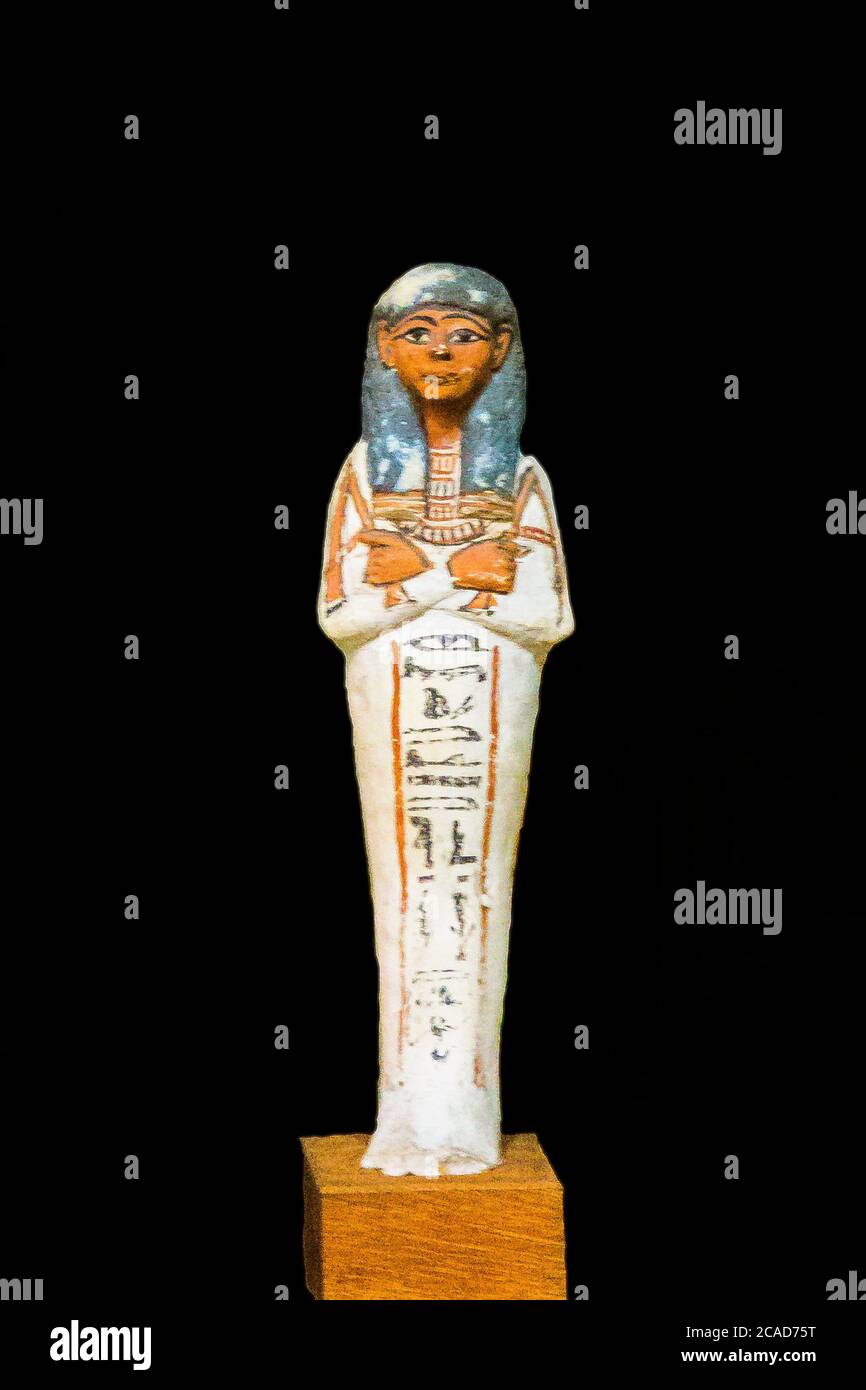 Egypt, Cairo, Egyptian Museum, from the tomb of Sennedjem, Deir el Medina : Ushebti of Sennedjem. Stock Photohttps://www.alamy.com/image-license-details/?v=1https://www.alamy.com/egypt-cairo-egyptian-museum-from-the-tomb-of-sennedjem-deir-el-medina-ushebti-of-sennedjem-image367855316.html
Egypt, Cairo, Egyptian Museum, from the tomb of Sennedjem, Deir el Medina : Ushebti of Sennedjem. Stock Photohttps://www.alamy.com/image-license-details/?v=1https://www.alamy.com/egypt-cairo-egyptian-museum-from-the-tomb-of-sennedjem-deir-el-medina-ushebti-of-sennedjem-image367855316.htmlRM2CAD75T–Egypt, Cairo, Egyptian Museum, from the tomb of Sennedjem, Deir el Medina : Ushebti of Sennedjem.
 Ancient Egyptian Ushabti box, 664-332 BC, Thebes, painted wood. Louvre Museum N2697. Decoration: front side; the 4 sons of Horus (standing); isis : ta Stock Photohttps://www.alamy.com/image-license-details/?v=1https://www.alamy.com/ancient-egyptian-ushabti-box-664-332-bc-thebes-painted-wood-louvre-museum-n2697-decoration-front-side-the-4-sons-of-horus-standing-isis-ta-image450438791.html
Ancient Egyptian Ushabti box, 664-332 BC, Thebes, painted wood. Louvre Museum N2697. Decoration: front side; the 4 sons of Horus (standing); isis : ta Stock Photohttps://www.alamy.com/image-license-details/?v=1https://www.alamy.com/ancient-egyptian-ushabti-box-664-332-bc-thebes-painted-wood-louvre-museum-n2697-decoration-front-side-the-4-sons-of-horus-standing-isis-ta-image450438791.htmlRF2H4R77K–Ancient Egyptian Ushabti box, 664-332 BC, Thebes, painted wood. Louvre Museum N2697. Decoration: front side; the 4 sons of Horus (standing); isis : ta
 200131 -- MINYA, Jan. 31, 2020 -- Newly discovered ushabti statuettes are seen in Province of Minya, Egypt, on Jan. 30, 2020. The Egyptian Ministry of Tourism and Antiquities announced on Thursday the discovery of 16 ancient tombs with about 20 sarcophagi and thousands of funerary objects at a necropolis in Upper Egypt s Province of Minya. EGYPT-MINYA-ARCHEOLOGICAL DISCOVERY WuxHuiwo PUBLICATIONxNOTxINxCHN Stock Photohttps://www.alamy.com/image-license-details/?v=1https://www.alamy.com/200131-minya-jan-31-2020-newly-discovered-ushabti-statuettes-are-seen-in-province-of-minya-egypt-on-jan-30-2020-the-egyptian-ministry-of-tourism-and-antiquities-announced-on-thursday-the-discovery-of-16-ancient-tombs-with-about-20-sarcophagi-and-thousands-of-funerary-objects-at-a-necropolis-in-upper-egypt-s-province-of-minya-egypt-minya-archeological-discovery-wuxhuiwo-publicationxnotxinxchn-image564698311.html
200131 -- MINYA, Jan. 31, 2020 -- Newly discovered ushabti statuettes are seen in Province of Minya, Egypt, on Jan. 30, 2020. The Egyptian Ministry of Tourism and Antiquities announced on Thursday the discovery of 16 ancient tombs with about 20 sarcophagi and thousands of funerary objects at a necropolis in Upper Egypt s Province of Minya. EGYPT-MINYA-ARCHEOLOGICAL DISCOVERY WuxHuiwo PUBLICATIONxNOTxINxCHN Stock Photohttps://www.alamy.com/image-license-details/?v=1https://www.alamy.com/200131-minya-jan-31-2020-newly-discovered-ushabti-statuettes-are-seen-in-province-of-minya-egypt-on-jan-30-2020-the-egyptian-ministry-of-tourism-and-antiquities-announced-on-thursday-the-discovery-of-16-ancient-tombs-with-about-20-sarcophagi-and-thousands-of-funerary-objects-at-a-necropolis-in-upper-egypt-s-province-of-minya-egypt-minya-archeological-discovery-wuxhuiwo-publicationxnotxinxchn-image564698311.htmlRM2RPM6CR–200131 -- MINYA, Jan. 31, 2020 -- Newly discovered ushabti statuettes are seen in Province of Minya, Egypt, on Jan. 30, 2020. The Egyptian Ministry of Tourism and Antiquities announced on Thursday the discovery of 16 ancient tombs with about 20 sarcophagi and thousands of funerary objects at a necropolis in Upper Egypt s Province of Minya. EGYPT-MINYA-ARCHEOLOGICAL DISCOVERY WuxHuiwo PUBLICATIONxNOTxINxCHN
 Ushabti figure found in Tutankhamun's tomb. The Treasures of Tutankhamen, The Exhibition Catalogue by I E S Edwards, page 83. Stock Photohttps://www.alamy.com/image-license-details/?v=1https://www.alamy.com/ushabti-figure-found-in-tutankhamuns-tomb-the-treasures-of-tutankhamen-the-exhibition-catalogue-by-i-e-s-edwards-page-83-image268793595.html
Ushabti figure found in Tutankhamun's tomb. The Treasures of Tutankhamen, The Exhibition Catalogue by I E S Edwards, page 83. Stock Photohttps://www.alamy.com/image-license-details/?v=1https://www.alamy.com/ushabti-figure-found-in-tutankhamuns-tomb-the-treasures-of-tutankhamen-the-exhibition-catalogue-by-i-e-s-edwards-page-83-image268793595.htmlRMWH8GY7–Ushabti figure found in Tutankhamun's tomb. The Treasures of Tutankhamen, The Exhibition Catalogue by I E S Edwards, page 83.
 x-ray of a crocodile mummy Stock Photohttps://www.alamy.com/image-license-details/?v=1https://www.alamy.com/x-ray-of-a-crocodile-mummy-image555843472.html
x-ray of a crocodile mummy Stock Photohttps://www.alamy.com/image-license-details/?v=1https://www.alamy.com/x-ray-of-a-crocodile-mummy-image555843472.htmlRM2R88T0G–x-ray of a crocodile mummy
 geography/travel, Egypt, death cult, canopic jar for shabti, painted clay, 1300 - 1200 BC, 19th dynasty, State Collection of Egyptian Art, Munich, Duamutef , Qebehsenuef, ancient world, ushabti, fine arts, historic, historical, ancient world, Stock Photohttps://www.alamy.com/image-license-details/?v=1https://www.alamy.com/stock-photo-geographytravel-egypt-death-cult-canopic-jar-for-shabti-painted-clay-12825272.html
geography/travel, Egypt, death cult, canopic jar for shabti, painted clay, 1300 - 1200 BC, 19th dynasty, State Collection of Egyptian Art, Munich, Duamutef , Qebehsenuef, ancient world, ushabti, fine arts, historic, historical, ancient world, Stock Photohttps://www.alamy.com/image-license-details/?v=1https://www.alamy.com/stock-photo-geographytravel-egypt-death-cult-canopic-jar-for-shabti-painted-clay-12825272.htmlRMAB9W3N–geography/travel, Egypt, death cult, canopic jar for shabti, painted clay, 1300 - 1200 BC, 19th dynasty, State Collection of Egyptian Art, Munich, Duamutef , Qebehsenuef, ancient world, ushabti, fine arts, historic, historical, ancient world,
 Egyptian Ushabti or ushabtis. The ushabti also called shabti or shawabti, was an Ancient Egyptian funerary figurine Stock Photohttps://www.alamy.com/image-license-details/?v=1https://www.alamy.com/stock-photo-egyptian-ushabti-or-ushabtis-the-ushabti-also-called-shabti-or-shawabti-90846100.html
Egyptian Ushabti or ushabtis. The ushabti also called shabti or shawabti, was an Ancient Egyptian funerary figurine Stock Photohttps://www.alamy.com/image-license-details/?v=1https://www.alamy.com/stock-photo-egyptian-ushabti-or-ushabtis-the-ushabti-also-called-shabti-or-shawabti-90846100.htmlRMF7PB3G–Egyptian Ushabti or ushabtis. The ushabti also called shabti or shawabti, was an Ancient Egyptian funerary figurine
 Ancient Egyptian. Shabti of Horu. 664 BC–525 BC. Egypt. Faience To assure themselves a comfortable afterlife, Egyptians stocked their tombs with at least one figurine called an ushabti, who acted as a servant in the afterlife. The message carved on each of the figurines explained that if the deceased is called on to do any work in the afterlife, the ushabti will respond with “Here I am” and will do the job. Some tombs had as many as one ushabti for every day of the year and another 36 overseers to keep order. All but the poorest citizens provided themselves with some kind of funerary furnishin Stock Photohttps://www.alamy.com/image-license-details/?v=1https://www.alamy.com/ancient-egyptian-shabti-of-horu-664-bc525-bc-egypt-faience-to-assure-themselves-a-comfortable-afterlife-egyptians-stocked-their-tombs-with-at-least-one-figurine-called-an-ushabti-who-acted-as-a-servant-in-the-afterlife-the-message-carved-on-each-of-the-figurines-explained-that-if-the-deceased-is-called-on-to-do-any-work-in-the-afterlife-the-ushabti-will-respond-with-here-i-am-and-will-do-the-job-some-tombs-had-as-many-as-one-ushabti-for-every-day-of-the-year-and-another-36-overseers-to-keep-order-all-but-the-poorest-citizens-provided-themselves-with-some-kind-of-funerary-furnishin-image337931807.html
Ancient Egyptian. Shabti of Horu. 664 BC–525 BC. Egypt. Faience To assure themselves a comfortable afterlife, Egyptians stocked their tombs with at least one figurine called an ushabti, who acted as a servant in the afterlife. The message carved on each of the figurines explained that if the deceased is called on to do any work in the afterlife, the ushabti will respond with “Here I am” and will do the job. Some tombs had as many as one ushabti for every day of the year and another 36 overseers to keep order. All but the poorest citizens provided themselves with some kind of funerary furnishin Stock Photohttps://www.alamy.com/image-license-details/?v=1https://www.alamy.com/ancient-egyptian-shabti-of-horu-664-bc525-bc-egypt-faience-to-assure-themselves-a-comfortable-afterlife-egyptians-stocked-their-tombs-with-at-least-one-figurine-called-an-ushabti-who-acted-as-a-servant-in-the-afterlife-the-message-carved-on-each-of-the-figurines-explained-that-if-the-deceased-is-called-on-to-do-any-work-in-the-afterlife-the-ushabti-will-respond-with-here-i-am-and-will-do-the-job-some-tombs-had-as-many-as-one-ushabti-for-every-day-of-the-year-and-another-36-overseers-to-keep-order-all-but-the-poorest-citizens-provided-themselves-with-some-kind-of-funerary-furnishin-image337931807.htmlRM2AHP3D3–Ancient Egyptian. Shabti of Horu. 664 BC–525 BC. Egypt. Faience To assure themselves a comfortable afterlife, Egyptians stocked their tombs with at least one figurine called an ushabti, who acted as a servant in the afterlife. The message carved on each of the figurines explained that if the deceased is called on to do any work in the afterlife, the ushabti will respond with “Here I am” and will do the job. Some tombs had as many as one ushabti for every day of the year and another 36 overseers to keep order. All but the poorest citizens provided themselves with some kind of funerary furnishin
 Shabti Chebeny (17th-18th century BC) (C. 1630-1500 BC) Funerary figurine.Ancient Egypt. Stock Photohttps://www.alamy.com/image-license-details/?v=1https://www.alamy.com/shabti-chebeny-17th-18th-century-bc-c-1630-1500-bc-funerary-figurineancient-egypt-image575835069.html
Shabti Chebeny (17th-18th century BC) (C. 1630-1500 BC) Funerary figurine.Ancient Egypt. Stock Photohttps://www.alamy.com/image-license-details/?v=1https://www.alamy.com/shabti-chebeny-17th-18th-century-bc-c-1630-1500-bc-funerary-figurineancient-egypt-image575835069.htmlRM2TCRFE5–Shabti Chebeny (17th-18th century BC) (C. 1630-1500 BC) Funerary figurine.Ancient Egypt.
 Berlin, New Museum, Uschebtikasten (New Museum, ushabti box) Uschebtis were often found in very large numbers in the graves because they were given as helpers to work in the afterlife for the deceased who lived there according to ancient Egyptian understanding. Stock Photohttps://www.alamy.com/image-license-details/?v=1https://www.alamy.com/stock-photo-berlin-new-museum-uschebtikasten-new-museum-ushabti-box-uschebtis-134984931.html
Berlin, New Museum, Uschebtikasten (New Museum, ushabti box) Uschebtis were often found in very large numbers in the graves because they were given as helpers to work in the afterlife for the deceased who lived there according to ancient Egyptian understanding. Stock Photohttps://www.alamy.com/image-license-details/?v=1https://www.alamy.com/stock-photo-berlin-new-museum-uschebtikasten-new-museum-ushabti-box-uschebtis-134984931.htmlRMHRH2JB–Berlin, New Museum, Uschebtikasten (New Museum, ushabti box) Uschebtis were often found in very large numbers in the graves because they were given as helpers to work in the afterlife for the deceased who lived there according to ancient Egyptian understanding.
 Ancient Egypt. Ushabti. Funerary figurine. Limestone. The State Hermitage Museum. Saint Petersburg. Russia. Stock Photohttps://www.alamy.com/image-license-details/?v=1https://www.alamy.com/ancient-egypt-ushabti-funerary-figurine-limestone-the-state-hermitage-museum-saint-petersburg-russia-image211215419.html
Ancient Egypt. Ushabti. Funerary figurine. Limestone. The State Hermitage Museum. Saint Petersburg. Russia. Stock Photohttps://www.alamy.com/image-license-details/?v=1https://www.alamy.com/ancient-egypt-ushabti-funerary-figurine-limestone-the-state-hermitage-museum-saint-petersburg-russia-image211215419.htmlRMP7HKBR–Ancient Egypt. Ushabti. Funerary figurine. Limestone. The State Hermitage Museum. Saint Petersburg. Russia.
 Ushabti of Pindjem I Stock Photohttps://www.alamy.com/image-license-details/?v=1https://www.alamy.com/ushabti-of-pindjem-i-image553137109.html
Ushabti of Pindjem I Stock Photohttps://www.alamy.com/image-license-details/?v=1https://www.alamy.com/ushabti-of-pindjem-i-image553137109.htmlRM2R3WG0N–Ushabti of Pindjem I
 Tutankhamun tomb treasures; painted wooden shabtis, or figurines wearing Nemes Headdress and Nubian Wig, from Ancient Egypt Stock Photohttps://www.alamy.com/image-license-details/?v=1https://www.alamy.com/tutankhamun-tomb-treasures-painted-wooden-shabtis-or-figurines-wearing-nemes-headdress-and-nubian-wig-from-ancient-egypt-image349175189.html
Tutankhamun tomb treasures; painted wooden shabtis, or figurines wearing Nemes Headdress and Nubian Wig, from Ancient Egypt Stock Photohttps://www.alamy.com/image-license-details/?v=1https://www.alamy.com/tutankhamun-tomb-treasures-painted-wooden-shabtis-or-figurines-wearing-nemes-headdress-and-nubian-wig-from-ancient-egypt-image349175189.htmlRM2B828ED–Tutankhamun tomb treasures; painted wooden shabtis, or figurines wearing Nemes Headdress and Nubian Wig, from Ancient Egypt
 Ushabti of pharaoh Rameses VI Stock Photohttps://www.alamy.com/image-license-details/?v=1https://www.alamy.com/ushabti-of-pharaoh-rameses-vi-image611218271.html
Ushabti of pharaoh Rameses VI Stock Photohttps://www.alamy.com/image-license-details/?v=1https://www.alamy.com/ushabti-of-pharaoh-rameses-vi-image611218271.htmlRM2XEBB3Y–Ushabti of pharaoh Rameses VI
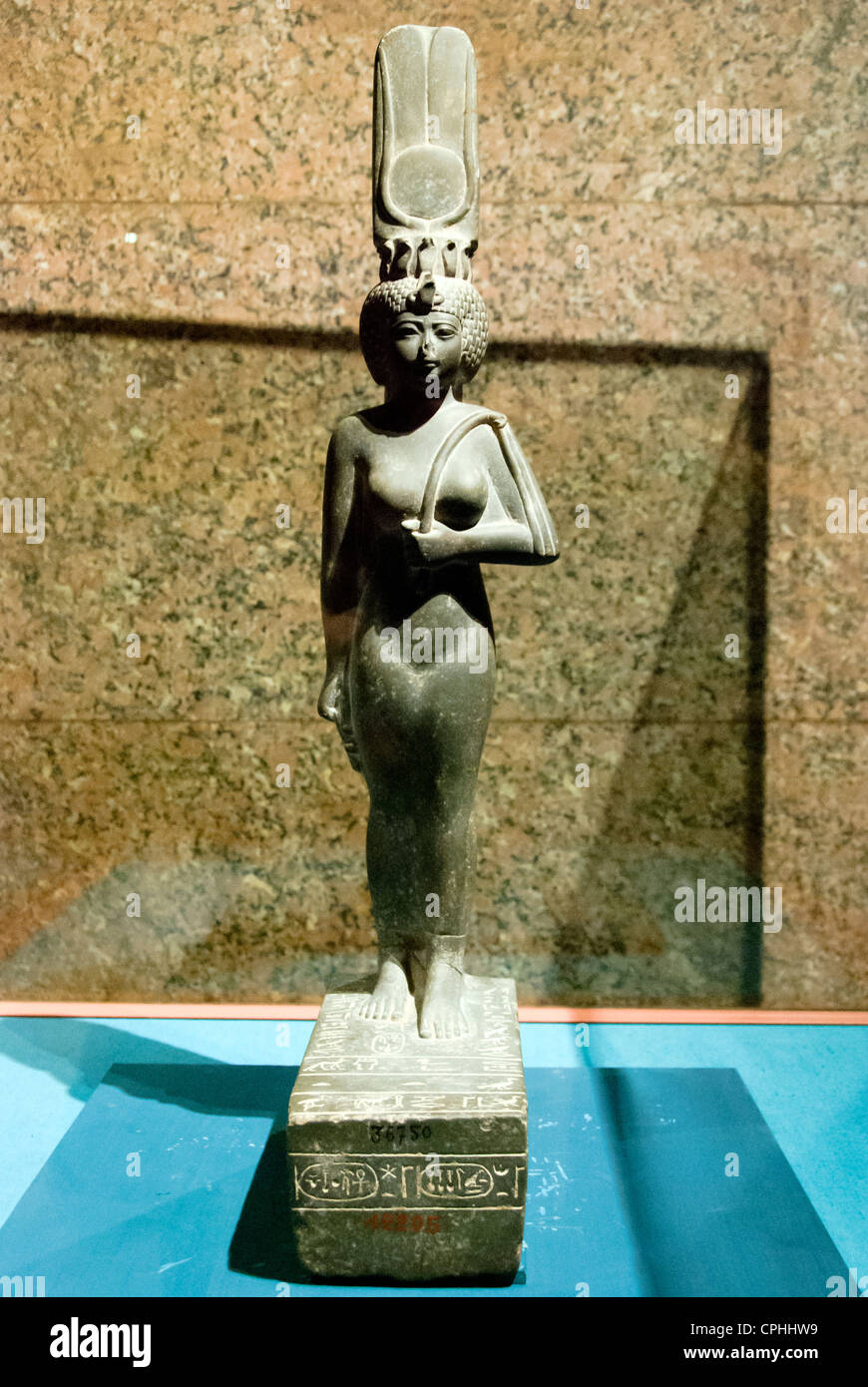 statue of Ushabti of Ankhnesneferibe - Nubian Museum - Aswan, Upper Egypt Stock Photohttps://www.alamy.com/image-license-details/?v=1https://www.alamy.com/stock-photo-statue-of-ushabti-of-ankhnesneferibe-nubian-museum-aswan-upper-egypt-48330389.html
statue of Ushabti of Ankhnesneferibe - Nubian Museum - Aswan, Upper Egypt Stock Photohttps://www.alamy.com/image-license-details/?v=1https://www.alamy.com/stock-photo-statue-of-ushabti-of-ankhnesneferibe-nubian-museum-aswan-upper-egypt-48330389.htmlRMCPHHW9–statue of Ushabti of Ankhnesneferibe - Nubian Museum - Aswan, Upper Egypt
 Giza, Egypt. 14th July, 2018. A general view of ancient Egyptian burial ushabti statuses that were discovered by a German-Egyptian mission, at the Saqqara burial ground in Giza, Egypt, 14 July 2018. Egyptian Minister of Antiquities Khaled El-Anani announced earlier in the day the discovery of a mummification workshop and a communal burial place, including several burial chambers with a collection of 35 mummies dating back to the Late Period of ancient Egypt. Credit: Mohamed El Raai/dpa/Alamy Live News Stock Photohttps://www.alamy.com/image-license-details/?v=1https://www.alamy.com/giza-egypt-14th-july-2018-a-general-view-of-ancient-egyptian-burial-ushabti-statuses-that-were-discovered-by-a-german-egyptian-mission-at-the-saqqara-burial-ground-in-giza-egypt-14-july-2018-egyptian-minister-of-antiquities-khaled-el-anani-announced-earlier-in-the-day-the-discovery-of-a-mummification-workshop-and-a-communal-burial-place-including-several-burial-chambers-with-a-collection-of-35-mummies-dating-back-to-the-late-period-of-ancient-egypt-credit-mohamed-el-raaidpaalamy-live-news-image212092074.html
Giza, Egypt. 14th July, 2018. A general view of ancient Egyptian burial ushabti statuses that were discovered by a German-Egyptian mission, at the Saqqara burial ground in Giza, Egypt, 14 July 2018. Egyptian Minister of Antiquities Khaled El-Anani announced earlier in the day the discovery of a mummification workshop and a communal burial place, including several burial chambers with a collection of 35 mummies dating back to the Late Period of ancient Egypt. Credit: Mohamed El Raai/dpa/Alamy Live News Stock Photohttps://www.alamy.com/image-license-details/?v=1https://www.alamy.com/giza-egypt-14th-july-2018-a-general-view-of-ancient-egyptian-burial-ushabti-statuses-that-were-discovered-by-a-german-egyptian-mission-at-the-saqqara-burial-ground-in-giza-egypt-14-july-2018-egyptian-minister-of-antiquities-khaled-el-anani-announced-earlier-in-the-day-the-discovery-of-a-mummification-workshop-and-a-communal-burial-place-including-several-burial-chambers-with-a-collection-of-35-mummies-dating-back-to-the-late-period-of-ancient-egypt-credit-mohamed-el-raaidpaalamy-live-news-image212092074.htmlRMP91HGX–Giza, Egypt. 14th July, 2018. A general view of ancient Egyptian burial ushabti statuses that were discovered by a German-Egyptian mission, at the Saqqara burial ground in Giza, Egypt, 14 July 2018. Egyptian Minister of Antiquities Khaled El-Anani announced earlier in the day the discovery of a mummification workshop and a communal burial place, including several burial chambers with a collection of 35 mummies dating back to the Late Period of ancient Egypt. Credit: Mohamed El Raai/dpa/Alamy Live News
 Egypt. Ushabti. (also called shabti). Funerary figurine, placed in tombs. Istanbul Archaeological Museum, Turkey. Stock Photohttps://www.alamy.com/image-license-details/?v=1https://www.alamy.com/egypt-ushabti-also-called-shabti-funerary-figurine-placed-in-tombs-istanbul-archaeological-museum-turkey-image345573520.html
Egypt. Ushabti. (also called shabti). Funerary figurine, placed in tombs. Istanbul Archaeological Museum, Turkey. Stock Photohttps://www.alamy.com/image-license-details/?v=1https://www.alamy.com/egypt-ushabti-also-called-shabti-funerary-figurine-placed-in-tombs-istanbul-archaeological-museum-turkey-image345573520.htmlRM2B266FC–Egypt. Ushabti. (also called shabti). Funerary figurine, placed in tombs. Istanbul Archaeological Museum, Turkey.
 201118 -- CAIRO, Nov. 18, 2020 -- Ushabti statuettes are seen at the Egyptian Museum in Cairo, Egypt, on Nov. 17, 2020. Egypt celebrated on Tuesday the 118th anniversary of the establishment of the Egyptian Museum located in downtown Cairo, which is home to an extensive collection of ancient Egyptian antiquities. EGYPT-CAIRO-EGYPTIAN MUSEUM-118TH ANNIVERSARY AhmedxGomaa PUBLICATIONxNOTxINxCHN Stock Photohttps://www.alamy.com/image-license-details/?v=1https://www.alamy.com/201118-cairo-nov-18-2020-ushabti-statuettes-are-seen-at-the-egyptian-museum-in-cairo-egypt-on-nov-17-2020-egypt-celebrated-on-tuesday-the-118th-anniversary-of-the-establishment-of-the-egyptian-museum-located-in-downtown-cairo-which-is-home-to-an-extensive-collection-of-ancient-egyptian-antiquities-egypt-cairo-egyptian-museum-118th-anniversary-ahmedxgomaa-publicationxnotxinxchn-image564958861.html
201118 -- CAIRO, Nov. 18, 2020 -- Ushabti statuettes are seen at the Egyptian Museum in Cairo, Egypt, on Nov. 17, 2020. Egypt celebrated on Tuesday the 118th anniversary of the establishment of the Egyptian Museum located in downtown Cairo, which is home to an extensive collection of ancient Egyptian antiquities. EGYPT-CAIRO-EGYPTIAN MUSEUM-118TH ANNIVERSARY AhmedxGomaa PUBLICATIONxNOTxINxCHN Stock Photohttps://www.alamy.com/image-license-details/?v=1https://www.alamy.com/201118-cairo-nov-18-2020-ushabti-statuettes-are-seen-at-the-egyptian-museum-in-cairo-egypt-on-nov-17-2020-egypt-celebrated-on-tuesday-the-118th-anniversary-of-the-establishment-of-the-egyptian-museum-located-in-downtown-cairo-which-is-home-to-an-extensive-collection-of-ancient-egyptian-antiquities-egypt-cairo-egyptian-museum-118th-anniversary-ahmedxgomaa-publicationxnotxinxchn-image564958861.htmlRM2RR42P5–201118 -- CAIRO, Nov. 18, 2020 -- Ushabti statuettes are seen at the Egyptian Museum in Cairo, Egypt, on Nov. 17, 2020. Egypt celebrated on Tuesday the 118th anniversary of the establishment of the Egyptian Museum located in downtown Cairo, which is home to an extensive collection of ancient Egyptian antiquities. EGYPT-CAIRO-EGYPTIAN MUSEUM-118TH ANNIVERSARY AhmedxGomaa PUBLICATIONxNOTxINxCHN
 Shabti box of Mutemuia. Third Intermediate Period, 21st Dynasty, Egypt. Stuccoed and painted wood. Archaeoilogical Museum, Naples. Stock Photohttps://www.alamy.com/image-license-details/?v=1https://www.alamy.com/shabti-box-of-mutemuia-third-intermediate-period-21st-dynasty-egypt-stuccoed-and-painted-wood-archaeoilogical-museum-naples-image337876663.html
Shabti box of Mutemuia. Third Intermediate Period, 21st Dynasty, Egypt. Stuccoed and painted wood. Archaeoilogical Museum, Naples. Stock Photohttps://www.alamy.com/image-license-details/?v=1https://www.alamy.com/shabti-box-of-mutemuia-third-intermediate-period-21st-dynasty-egypt-stuccoed-and-painted-wood-archaeoilogical-museum-naples-image337876663.htmlRM2AHKH3K–Shabti box of Mutemuia. Third Intermediate Period, 21st Dynasty, Egypt. Stuccoed and painted wood. Archaeoilogical Museum, Naples.
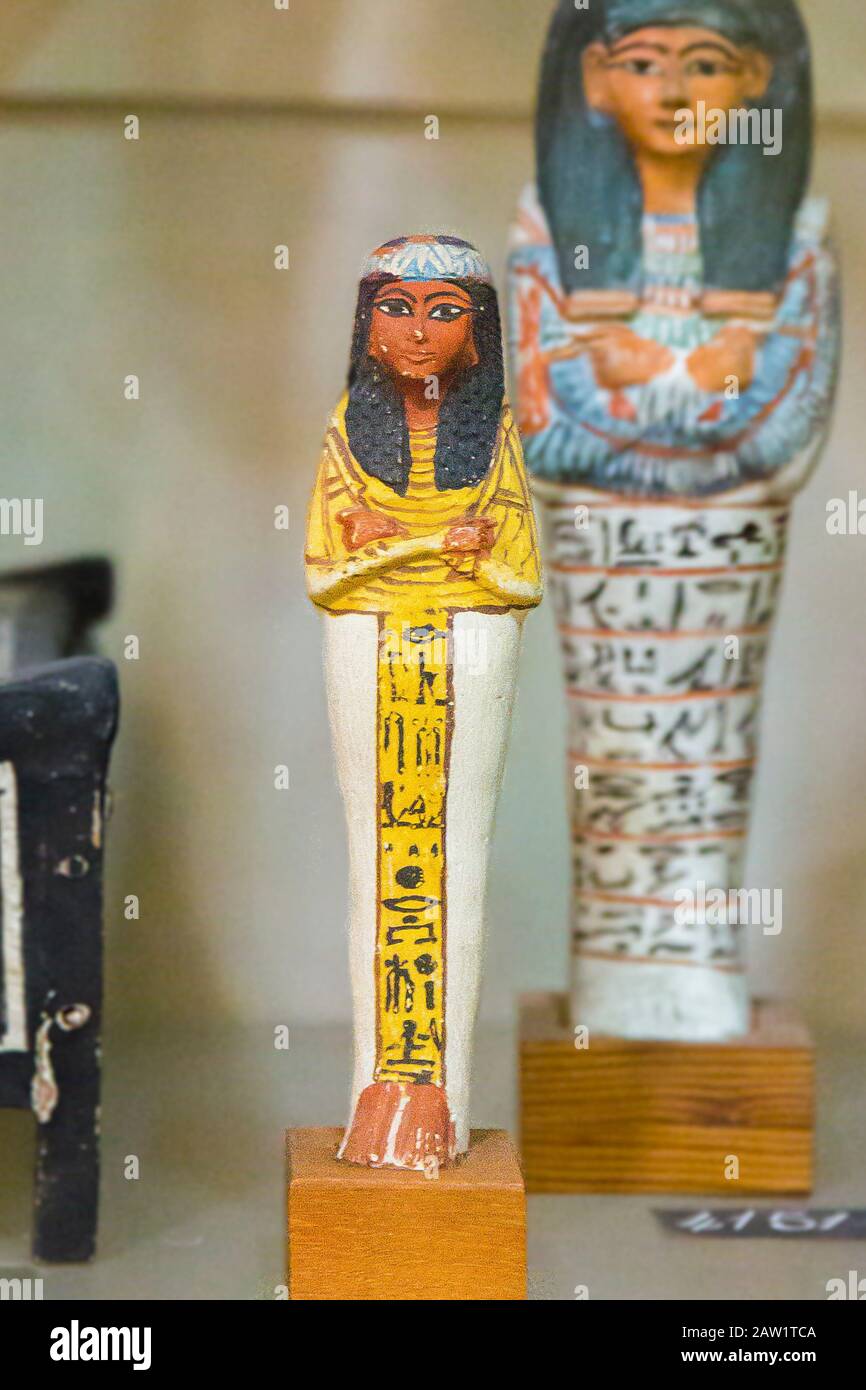 Egypt, Cairo, Egyptian Museum, from the tomb of Sennedjem, Deir el Medina : Ushebti of Ramesu, maybe a son of Sennedjem. Stock Photohttps://www.alamy.com/image-license-details/?v=1https://www.alamy.com/egypt-cairo-egyptian-museum-from-the-tomb-of-sennedjem-deir-el-medina-ushebti-of-ramesu-maybe-a-son-of-sennedjem-image342404506.html
Egypt, Cairo, Egyptian Museum, from the tomb of Sennedjem, Deir el Medina : Ushebti of Ramesu, maybe a son of Sennedjem. Stock Photohttps://www.alamy.com/image-license-details/?v=1https://www.alamy.com/egypt-cairo-egyptian-museum-from-the-tomb-of-sennedjem-deir-el-medina-ushebti-of-ramesu-maybe-a-son-of-sennedjem-image342404506.htmlRM2AW1TCA–Egypt, Cairo, Egyptian Museum, from the tomb of Sennedjem, Deir el Medina : Ushebti of Ramesu, maybe a son of Sennedjem.
 Ancient Egyptian Ushabti box, 664-332 BC, Thebes, painted wood. Louvre Museum N2697. Decoration: front side; the 4 sons of Horus (standing); isis : ta Stock Photohttps://www.alamy.com/image-license-details/?v=1https://www.alamy.com/ancient-egyptian-ushabti-box-664-332-bc-thebes-painted-wood-louvre-museum-n2697-decoration-front-side-the-4-sons-of-horus-standing-isis-ta-image450449286.html
Ancient Egyptian Ushabti box, 664-332 BC, Thebes, painted wood. Louvre Museum N2697. Decoration: front side; the 4 sons of Horus (standing); isis : ta Stock Photohttps://www.alamy.com/image-license-details/?v=1https://www.alamy.com/ancient-egyptian-ushabti-box-664-332-bc-thebes-painted-wood-louvre-museum-n2697-decoration-front-side-the-4-sons-of-horus-standing-isis-ta-image450449286.htmlRF2H4RMJE–Ancient Egyptian Ushabti box, 664-332 BC, Thebes, painted wood. Louvre Museum N2697. Decoration: front side; the 4 sons of Horus (standing); isis : ta
 Egypt, Cairo, Egyptian Museum, jewellery found in the royal necropolis of Tanis : Miniature mallet for an ushebti. Stock Photohttps://www.alamy.com/image-license-details/?v=1https://www.alamy.com/egypt-cairo-egyptian-museum-jewellery-found-in-the-royal-necropolis-of-tanis-miniature-mallet-for-an-ushebti-image367978444.html
Egypt, Cairo, Egyptian Museum, jewellery found in the royal necropolis of Tanis : Miniature mallet for an ushebti. Stock Photohttps://www.alamy.com/image-license-details/?v=1https://www.alamy.com/egypt-cairo-egyptian-museum-jewellery-found-in-the-royal-necropolis-of-tanis-miniature-mallet-for-an-ushebti-image367978444.htmlRM2CAJT78–Egypt, Cairo, Egyptian Museum, jewellery found in the royal necropolis of Tanis : Miniature mallet for an ushebti.
 Ancient Egyptian shabtis doll, New Kingdom,. Egyptian Museum, Turin. Grey background. Stock Photohttps://www.alamy.com/image-license-details/?v=1https://www.alamy.com/ancient-egyptian-shabtis-doll-new-kingdom-egyptian-museum-turin-grey-background-image361838403.html
Ancient Egyptian shabtis doll, New Kingdom,. Egyptian Museum, Turin. Grey background. Stock Photohttps://www.alamy.com/image-license-details/?v=1https://www.alamy.com/ancient-egyptian-shabtis-doll-new-kingdom-egyptian-museum-turin-grey-background-image361838403.htmlRF2C0K4G3–Ancient Egyptian shabtis doll, New Kingdom,. Egyptian Museum, Turin. Grey background.
 One of the many ushabtis of Tutankhamen wearing the red crown of the North. Tukankhamen by Christiane Desroches Noblecourt, page 171.. Ancient Egypt was once divided into two kingdoms. The kingdom in Lower Egypt was called the red crown and the Kingdom in Upper Egypt was known as the white crown.. A Ushabti (also called shabti or shawabti) is a small figurine of Ancient Egypt, included in the grave goods of the dead. They are human form statues that were made to serve and do labour in the afterlife of King Tut. The figure was believed to magically animate after the dead had been judged and Stock Photohttps://www.alamy.com/image-license-details/?v=1https://www.alamy.com/one-of-the-many-ushabtis-of-tutankhamen-wearing-the-red-crown-of-the-north-tukankhamen-by-christiane-desroches-noblecourt-page-171-ancient-egypt-was-once-divided-into-two-kingdoms-the-kingdom-in-lower-egypt-was-called-the-red-crown-and-the-kingdom-in-upper-egypt-was-known-as-the-white-crown-a-ushabti-also-called-shabti-or-shawabti-is-a-small-figurine-of-ancient-egypt-included-in-the-grave-goods-of-the-dead-they-are-human-form-statues-that-were-made-to-serve-and-do-labour-in-the-afterlife-of-king-tut-the-figure-was-believed-to-magically-animate-after-the-dead-had-been-judged-and-image268845636.html
One of the many ushabtis of Tutankhamen wearing the red crown of the North. Tukankhamen by Christiane Desroches Noblecourt, page 171.. Ancient Egypt was once divided into two kingdoms. The kingdom in Lower Egypt was called the red crown and the Kingdom in Upper Egypt was known as the white crown.. A Ushabti (also called shabti or shawabti) is a small figurine of Ancient Egypt, included in the grave goods of the dead. They are human form statues that were made to serve and do labour in the afterlife of King Tut. The figure was believed to magically animate after the dead had been judged and Stock Photohttps://www.alamy.com/image-license-details/?v=1https://www.alamy.com/one-of-the-many-ushabtis-of-tutankhamen-wearing-the-red-crown-of-the-north-tukankhamen-by-christiane-desroches-noblecourt-page-171-ancient-egypt-was-once-divided-into-two-kingdoms-the-kingdom-in-lower-egypt-was-called-the-red-crown-and-the-kingdom-in-upper-egypt-was-known-as-the-white-crown-a-ushabti-also-called-shabti-or-shawabti-is-a-small-figurine-of-ancient-egypt-included-in-the-grave-goods-of-the-dead-they-are-human-form-statues-that-were-made-to-serve-and-do-labour-in-the-afterlife-of-king-tut-the-figure-was-believed-to-magically-animate-after-the-dead-had-been-judged-and-image268845636.htmlRMWHAY9T–One of the many ushabtis of Tutankhamen wearing the red crown of the North. Tukankhamen by Christiane Desroches Noblecourt, page 171.. Ancient Egypt was once divided into two kingdoms. The kingdom in Lower Egypt was called the red crown and the Kingdom in Upper Egypt was known as the white crown.. A Ushabti (also called shabti or shawabti) is a small figurine of Ancient Egypt, included in the grave goods of the dead. They are human form statues that were made to serve and do labour in the afterlife of King Tut. The figure was believed to magically animate after the dead had been judged and
 Shabti Figures Carved From Limestone Stock Photohttps://www.alamy.com/image-license-details/?v=1https://www.alamy.com/shabti-figures-carved-from-limestone-image62590771.html
Shabti Figures Carved From Limestone Stock Photohttps://www.alamy.com/image-license-details/?v=1https://www.alamy.com/shabti-figures-carved-from-limestone-image62590771.htmlRMDHR74K–Shabti Figures Carved From Limestone
 Egyptian Ushabti or ushabtis. The ushabti also called shabti or shawabti, was an Ancient Egyptian funerary figurine Stock Photohttps://www.alamy.com/image-license-details/?v=1https://www.alamy.com/stock-photo-egyptian-ushabti-or-ushabtis-the-ushabti-also-called-shabti-or-shawabti-90845497.html
Egyptian Ushabti or ushabtis. The ushabti also called shabti or shawabti, was an Ancient Egyptian funerary figurine Stock Photohttps://www.alamy.com/image-license-details/?v=1https://www.alamy.com/stock-photo-egyptian-ushabti-or-ushabtis-the-ushabti-also-called-shabti-or-shawabti-90845497.htmlRMF7PAA1–Egyptian Ushabti or ushabtis. The ushabti also called shabti or shawabti, was an Ancient Egyptian funerary figurine
 Ancient Egyptian. Shabti (Funerary Figurine) of Nebseni. 1570 BC–1292 BC. Egypt. Wood (tamarisk) and pigment To assure themselves a comfortable afterlife, Egyptians stocked their tombs with at least one figurine called an ushabti, who acted as a servant in the afterlife. The message carved on each of the figurines explained that if the deceased is called on to do any work in the afterlife, the ushabti will respond with “Here I am” and will do the job. Some tombs had as many as one ushabti for every day of the year and another 36 overseers to keep order. All but the poorest citizens provided th Stock Photohttps://www.alamy.com/image-license-details/?v=1https://www.alamy.com/ancient-egyptian-shabti-funerary-figurine-of-nebseni-1570-bc1292-bc-egypt-wood-tamarisk-and-pigment-to-assure-themselves-a-comfortable-afterlife-egyptians-stocked-their-tombs-with-at-least-one-figurine-called-an-ushabti-who-acted-as-a-servant-in-the-afterlife-the-message-carved-on-each-of-the-figurines-explained-that-if-the-deceased-is-called-on-to-do-any-work-in-the-afterlife-the-ushabti-will-respond-with-here-i-am-and-will-do-the-job-some-tombs-had-as-many-as-one-ushabti-for-every-day-of-the-year-and-another-36-overseers-to-keep-order-all-but-the-poorest-citizens-provided-th-image337931810.html
Ancient Egyptian. Shabti (Funerary Figurine) of Nebseni. 1570 BC–1292 BC. Egypt. Wood (tamarisk) and pigment To assure themselves a comfortable afterlife, Egyptians stocked their tombs with at least one figurine called an ushabti, who acted as a servant in the afterlife. The message carved on each of the figurines explained that if the deceased is called on to do any work in the afterlife, the ushabti will respond with “Here I am” and will do the job. Some tombs had as many as one ushabti for every day of the year and another 36 overseers to keep order. All but the poorest citizens provided th Stock Photohttps://www.alamy.com/image-license-details/?v=1https://www.alamy.com/ancient-egyptian-shabti-funerary-figurine-of-nebseni-1570-bc1292-bc-egypt-wood-tamarisk-and-pigment-to-assure-themselves-a-comfortable-afterlife-egyptians-stocked-their-tombs-with-at-least-one-figurine-called-an-ushabti-who-acted-as-a-servant-in-the-afterlife-the-message-carved-on-each-of-the-figurines-explained-that-if-the-deceased-is-called-on-to-do-any-work-in-the-afterlife-the-ushabti-will-respond-with-here-i-am-and-will-do-the-job-some-tombs-had-as-many-as-one-ushabti-for-every-day-of-the-year-and-another-36-overseers-to-keep-order-all-but-the-poorest-citizens-provided-th-image337931810.htmlRM2AHP3D6–Ancient Egyptian. Shabti (Funerary Figurine) of Nebseni. 1570 BC–1292 BC. Egypt. Wood (tamarisk) and pigment To assure themselves a comfortable afterlife, Egyptians stocked their tombs with at least one figurine called an ushabti, who acted as a servant in the afterlife. The message carved on each of the figurines explained that if the deceased is called on to do any work in the afterlife, the ushabti will respond with “Here I am” and will do the job. Some tombs had as many as one ushabti for every day of the year and another 36 overseers to keep order. All but the poorest citizens provided th
 Shabti Chebeny (17th-18th century BC) (C. 1630-1500 BC) Funerary figurine.Ancient Egypt. Stock Photohttps://www.alamy.com/image-license-details/?v=1https://www.alamy.com/shabti-chebeny-17th-18th-century-bc-c-1630-1500-bc-funerary-figurineancient-egypt-image575835067.html
Shabti Chebeny (17th-18th century BC) (C. 1630-1500 BC) Funerary figurine.Ancient Egypt. Stock Photohttps://www.alamy.com/image-license-details/?v=1https://www.alamy.com/shabti-chebeny-17th-18th-century-bc-c-1630-1500-bc-funerary-figurineancient-egypt-image575835067.htmlRM2TCRFE3–Shabti Chebeny (17th-18th century BC) (C. 1630-1500 BC) Funerary figurine.Ancient Egypt.
 Berlin, New Museum, Uschebtikasten (New Museum, ushabti box) Uschebtis were often found in very large numbers in the graves because they were given as helpers to work in the afterlife for the deceased who lived there according to ancient Egyptian understanding. Stock Photohttps://www.alamy.com/image-license-details/?v=1https://www.alamy.com/stock-photo-berlin-new-museum-uschebtikasten-new-museum-ushabti-box-uschebtis-134945072.html
Berlin, New Museum, Uschebtikasten (New Museum, ushabti box) Uschebtis were often found in very large numbers in the graves because they were given as helpers to work in the afterlife for the deceased who lived there according to ancient Egyptian understanding. Stock Photohttps://www.alamy.com/image-license-details/?v=1https://www.alamy.com/stock-photo-berlin-new-museum-uschebtikasten-new-museum-ushabti-box-uschebtis-134945072.htmlRMHRF7PT–Berlin, New Museum, Uschebtikasten (New Museum, ushabti box) Uschebtis were often found in very large numbers in the graves because they were given as helpers to work in the afterlife for the deceased who lived there according to ancient Egyptian understanding.
 Shabti. Egyptian. Date: 1069 BC-945 BC. Dimensions: 15.5 × 5 × 3 cm (6 × 2 × 1 3/16 in.). Faience. Origin: Egypt. Museum: The Chicago Art Institute. Author: Ancient Egyptian. Stock Photohttps://www.alamy.com/image-license-details/?v=1https://www.alamy.com/shabti-egyptian-date-1069-bc-945-bc-dimensions-155-5-3-cm-6-2-1-316-in-faience-origin-egypt-museum-the-chicago-art-institute-author-ancient-egyptian-image239739939.html
Shabti. Egyptian. Date: 1069 BC-945 BC. Dimensions: 15.5 × 5 × 3 cm (6 × 2 × 1 3/16 in.). Faience. Origin: Egypt. Museum: The Chicago Art Institute. Author: Ancient Egyptian. Stock Photohttps://www.alamy.com/image-license-details/?v=1https://www.alamy.com/shabti-egyptian-date-1069-bc-945-bc-dimensions-155-5-3-cm-6-2-1-316-in-faience-origin-egypt-museum-the-chicago-art-institute-author-ancient-egyptian-image239739939.htmlRMRX12MK–Shabti. Egyptian. Date: 1069 BC-945 BC. Dimensions: 15.5 × 5 × 3 cm (6 × 2 × 1 3/16 in.). Faience. Origin: Egypt. Museum: The Chicago Art Institute. Author: Ancient Egyptian.
 VATICAN CITY - APRIL 5, 2016: an ancient Egyptian sarcophagus in Vatican Museums Stock Photohttps://www.alamy.com/image-license-details/?v=1https://www.alamy.com/vatican-city-april-5-2016-an-ancient-egyptian-sarcophagus-in-vatican-museums-image264436182.html
VATICAN CITY - APRIL 5, 2016: an ancient Egyptian sarcophagus in Vatican Museums Stock Photohttps://www.alamy.com/image-license-details/?v=1https://www.alamy.com/vatican-city-april-5-2016-an-ancient-egyptian-sarcophagus-in-vatican-museums-image264436182.htmlRFWA631A–VATICAN CITY - APRIL 5, 2016: an ancient Egyptian sarcophagus in Vatican Museums
 An Egyptian servant carries his master's baggage in this photo by 19th-century German Egyptologist Heinrich Karl Brugsch. Stock Photohttps://www.alamy.com/image-license-details/?v=1https://www.alamy.com/stock-photo-an-egyptian-servant-carries-his-masters-baggage-in-this-photo-by-19th-52518248.html
An Egyptian servant carries his master's baggage in this photo by 19th-century German Egyptologist Heinrich Karl Brugsch. Stock Photohttps://www.alamy.com/image-license-details/?v=1https://www.alamy.com/stock-photo-an-egyptian-servant-carries-his-masters-baggage-in-this-photo-by-19th-52518248.htmlRFD1CBFM–An Egyptian servant carries his master's baggage in this photo by 19th-century German Egyptologist Heinrich Karl Brugsch.
 Ancient object Stock Photohttps://www.alamy.com/image-license-details/?v=1https://www.alamy.com/ancient-object-image555840308.html
Ancient object Stock Photohttps://www.alamy.com/image-license-details/?v=1https://www.alamy.com/ancient-object-image555840308.htmlRM2R88KYG–Ancient object
 TURIN, ITALY - CIRCA DECEMBER 2022: Ushabti Statues At Museo Egizio Egyptian Museum Stock Photohttps://www.alamy.com/image-license-details/?v=1https://www.alamy.com/turin-italy-circa-december-2022-ushabti-statues-at-museo-egizio-egyptian-museum-image592334215.html
TURIN, ITALY - CIRCA DECEMBER 2022: Ushabti Statues At Museo Egizio Egyptian Museum Stock Photohttps://www.alamy.com/image-license-details/?v=1https://www.alamy.com/turin-italy-circa-december-2022-ushabti-statues-at-museo-egizio-egyptian-museum-image592334215.htmlRM2WBK49B–TURIN, ITALY - CIRCA DECEMBER 2022: Ushabti Statues At Museo Egizio Egyptian Museum
 Cairo,Egypt,December 31,2019-Ushabti, funerary figurines of Tutankhamun and his wife Ankhesenamun made of gilded wood and gesso from the KV62 tomb at the Museum of Egyptian antiquities in Cairo,Egypt Stock Photohttps://www.alamy.com/image-license-details/?v=1https://www.alamy.com/cairoegyptdecember-312019-ushabti-funerary-figurines-of-tutankhamun-and-his-wife-ankhesenamun-made-of-gilded-wood-and-gesso-from-the-kv62-tomb-at-the-museum-of-egyptian-antiquities-in-cairoegypt-image615761627.html
Cairo,Egypt,December 31,2019-Ushabti, funerary figurines of Tutankhamun and his wife Ankhesenamun made of gilded wood and gesso from the KV62 tomb at the Museum of Egyptian antiquities in Cairo,Egypt Stock Photohttps://www.alamy.com/image-license-details/?v=1https://www.alamy.com/cairoegyptdecember-312019-ushabti-funerary-figurines-of-tutankhamun-and-his-wife-ankhesenamun-made-of-gilded-wood-and-gesso-from-the-kv62-tomb-at-the-museum-of-egyptian-antiquities-in-cairoegypt-image615761627.htmlRF2XNPA6K–Cairo,Egypt,December 31,2019-Ushabti, funerary figurines of Tutankhamun and his wife Ankhesenamun made of gilded wood and gesso from the KV62 tomb at the Museum of Egyptian antiquities in Cairo,Egypt
 To assure themselves a comfortable afterlife, Egyptians stocked their tombs with at least one figurine called an ushabti, who acted as a servant in the afterlife. The message carved on each of the figurines explained that if the deceased is called on to do any work in the afterlife, the ushabti will respond with Here I am and will do the job. Some tombs had as many as one ushabti for every day of the year and another 36 overseers to keep order. All but the poorest citizens provided themselves with some kind of funerary furnishings. Products for burial and the labor to produce them made up a l Stock Photohttps://www.alamy.com/image-license-details/?v=1https://www.alamy.com/to-assure-themselves-a-comfortable-afterlife-egyptians-stocked-their-tombs-with-at-least-one-figurine-called-an-ushabti-who-acted-as-a-servant-in-the-afterlife-the-message-carved-on-each-of-the-figurines-explained-that-if-the-deceased-is-called-on-to-do-any-work-in-the-afterlife-the-ushabti-will-respond-with-here-i-am-and-will-do-the-job-some-tombs-had-as-many-as-one-ushabti-for-every-day-of-the-year-and-another-36-overseers-to-keep-order-all-but-the-poorest-citizens-provided-themselves-with-some-kind-of-funerary-furnishings-products-for-burial-and-the-labor-to-produce-them-made-up-a-l-image466190237.html
To assure themselves a comfortable afterlife, Egyptians stocked their tombs with at least one figurine called an ushabti, who acted as a servant in the afterlife. The message carved on each of the figurines explained that if the deceased is called on to do any work in the afterlife, the ushabti will respond with Here I am and will do the job. Some tombs had as many as one ushabti for every day of the year and another 36 overseers to keep order. All but the poorest citizens provided themselves with some kind of funerary furnishings. Products for burial and the labor to produce them made up a l Stock Photohttps://www.alamy.com/image-license-details/?v=1https://www.alamy.com/to-assure-themselves-a-comfortable-afterlife-egyptians-stocked-their-tombs-with-at-least-one-figurine-called-an-ushabti-who-acted-as-a-servant-in-the-afterlife-the-message-carved-on-each-of-the-figurines-explained-that-if-the-deceased-is-called-on-to-do-any-work-in-the-afterlife-the-ushabti-will-respond-with-here-i-am-and-will-do-the-job-some-tombs-had-as-many-as-one-ushabti-for-every-day-of-the-year-and-another-36-overseers-to-keep-order-all-but-the-poorest-citizens-provided-themselves-with-some-kind-of-funerary-furnishings-products-for-burial-and-the-labor-to-produce-them-made-up-a-l-image466190237.htmlRM2J2CPB9–To assure themselves a comfortable afterlife, Egyptians stocked their tombs with at least one figurine called an ushabti, who acted as a servant in the afterlife. The message carved on each of the figurines explained that if the deceased is called on to do any work in the afterlife, the ushabti will respond with Here I am and will do the job. Some tombs had as many as one ushabti for every day of the year and another 36 overseers to keep order. All but the poorest citizens provided themselves with some kind of funerary furnishings. Products for burial and the labor to produce them made up a l
